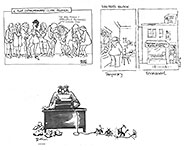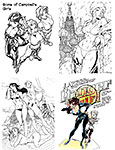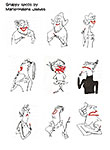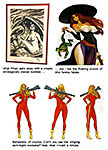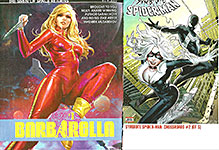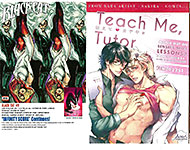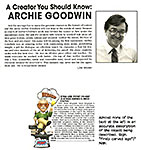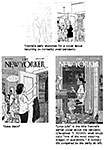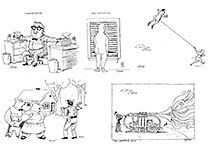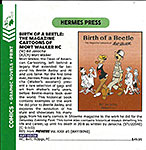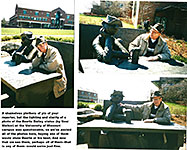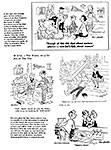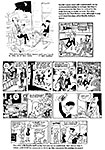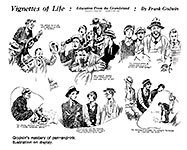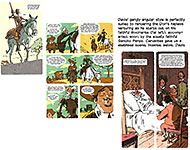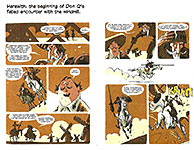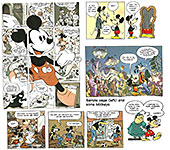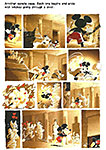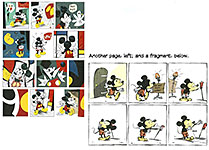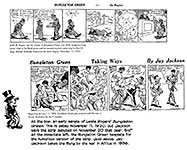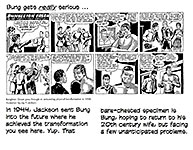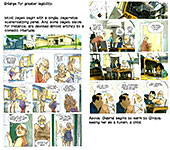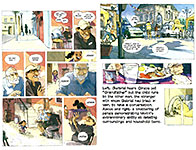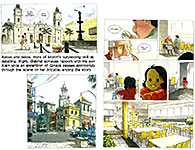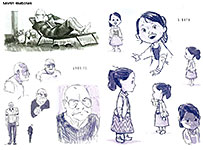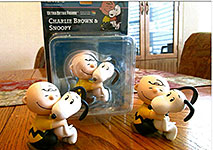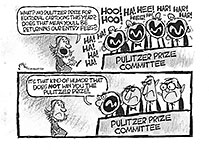 |
|||||||||||||||||||||||||||||||||||
Opus 419 (through June 30, 2021). We’ve packed a lot into this posting in order to showcase Rancid Raves for visitors during Open Access Month when even non-$ubscribers can wander the environs. (And after you have, we hope you’ll $ubscribe.) Charles Schulz all-adult characters comic strip, Vladimir Nabokov’s poem about Superman’s dilemma, Chaykin’s latest Hey, Kids! Comics!, plus ten book reviews, and more, much more. Here’s what’s here, by department, in order (the longest entries are marked with an asterisk* a reader’s guide to help you decide where to spend your time)—:
NOUS R US *No Pulitzer Prize for Editooning *Schulz Adult Character Strip *Gerberg Gets NCS Gold Key Award Denver Pop Cult Con Sells Out AAEC To Go Virtual for 2021 Convention The Nib Wins RFK Adams To Auction NFTs of His Art Rabbit Hole Reprints Erik Larsen to Relaunch Ant
ODDS & ADDENDA No Parade Approval of Chauvin Conviction Thriving Comicbook Shops FCBD August 14
FURTHER ADO *Lolita and Superman: “The Man of Tomorrow’s Lament” — Poem by Vladimir Nabokov (Yes: THAT Vladimir Nabokov)
FUNNYBOOK FAN FARE Chaykin’s Hey Kids! Comics—Volume II Spidey’s New Costume Brzrkr, No.2 Ha Ha, No.5
The World’s Comics Makers Unite for Batman Green Arrow 80th Anniversary 100-Page Super Spectacular No.1
TRUMPERIES The Antics and Idiocies of Our Former Bloviating Buffoon in Chief
*EDITOONERY The Mock in Democracy
NEWSPAPER COMICS PAGE VIGIL The Bump and Grind of Daily Stripping
ACCRETION OF INTENTION DEPARTMENT Older Books In Need of Good Reviews—: Books, Books, Books: A Hilarious Collection of Literary Cartoons Danger Girl: Permission to Thrill Coloring Book
RANCID RAVES GALLERY Pictures Without Too Many Words New Yorker Spots, Previews Pin-Ups, Archie Goodwin, Stan Lee Toys
Adrian Tomine’s “Ease Back” Cover for The New Yorker
BOOK MARQUEE Short Reviews and Proclamations of Coming Attractions—: Love and Other Weird Things, Cartoons by Rich Sparks Birth of a Beetle: The Magazine Cartoons of Mort Walker Rusty Riley: Volume Two, Dailies: 1949 - 1951 Can the Hulk Lift A House? The Complete Don Quixote Graphic Novel
Windsor-Smith Back with Monsters Graphic Novel
RECOMMENDED READING Six Books Selected by Alison Bechdel
BOOK REVIEWS Mickey All-Stars *It’s Life As I See It: Black Cartoonists in Chicago, 1940-1980
LONG FORM PAGINATED CARTOON STRIP Called Graphic Novel for the Sake of Status—: **The Adoption
COLLECTORS’ CORNICHE Charlie Brown Figurine Deluxe
PASSIN’ THROUGH *Richard Robinson of Scholastic
**Editoonist Clay Jones Reacts at Length to the No Prize Pulitzers
QUOTE OF THE MONTH If Not of A Lifetime “Goddamn it, you’ve got to be kind.”—Kurt Vonnegut Our Motto: It takes all kinds. Live and let live. Wear glasses if you need ’em. But it’s hard to live by this axiom in the Age of Tea Baggers, so we’ve added another motto: Seven days without comics makes one weak. (You can’t have too many mottos.) And in the same spirit, here’s—: Chatter matters, so let’s keep talking about comics. AND— “If we can imagine a better world, then we can make a better world.”
And our customary reminder: don’t forget to activate the “Bathroom Button” by clicking on the “print friendly version” so you can print off a copy of just this installment for reading later, at your leisure while enthroned. Without further adieu, then, here we go—:
NOUS R US Some of All the News That Gives Us Fits
NO PRIZE (The ensuing report was made by Bunny Bonus a couple weeks ago; we repeat it here because yr rprtr is forever in the grip of a compulsion to make Rancid Raves as stand-alone encyclopedic as possible. As if Bunny Bonuses weren’t part of the Eternal Record. Sigh. Besides, I added a little to that earlier report. Forgive me and plunge onward.) NO PULITZER PRIZE was awarded in the editorial cartoon category this year. Why not? It’s not because there are no editorial cartoonists. It’s not because no editorial cartoons were submitted to the Pulitzers. The Pulitzers just didn’t award editorial cartooning this year. No Prize. Nada. Or, as another less enraged observer said: “If there's any doubt remaining that the NY media elite have declared war on editorial cartooning, it's gone.” The “NY media elite” is a shot at the Pulitzer Board, which is based at Columbia University in New York City. Other comments/reactions were similarly edgy. Someone said the Pulitzer People ought to return the entry fee paid by all who entered this category. Someone else said: “Having ‘no award’ this year is offensive and outlandish, given the amount of outstanding editorial cartooning done in 2020.” I agree. Someone else observed that all three finalists in the Editorial Cartooning category are minorities: Latinx, Native American, and Jewish. “This is what systemic racism looks like.” But most agree that reaction is going too far. Instead, what we’re faced with is colossal overweening arrogance on the part of the Pulitzer Board. Here’s how the selection process supposedly “works.” A selection committee (called judges or jurors) screens all the submitted editoons. Editoonists submit portfolios of 15-20 editoons; this year, it was 15. And they pay an entry fee of $75. The selection committee then determines the three best portfolios and sends to the Pulitzer Board these three “finalists” from whom the Board is supposed to pick the winner. That’s how it’s supposed to work. And this year, everything worked until it became the Board’s turn. Then they screwed us all. This year, the Board ignored the recommendations inherent in the selection committee’s list of finalists and chose, instead, not to name a winner at all. Period. Actually, the situation is even worse, more high-handedly arrogant. Ann Telnaes tells me that the selection committee sends the Board two lists, each having three names: the first is the list of finalists; the second is a list of alternatives. The assumption is that if the Board can’t find a winner among the finalists, it can look at the alternatives. Hence, this year the Board ignored six recommendations. SIX. Said Telnaes: “Although not often, the Board has bypassed the 3 finalists in the past and awarded to an alternate— which makes this year all the more troubling. I do not agree with the AAEC statement [down the scroll] that discrimination against minorities and ‘alts’ was the reason. However, I fear this decision was influenced by pushback against cartooning and caricature on social media last year—which directly threatens all of us.” As Telanaes points out, this isn’t the first time the Pulitzers have awarded “no prize.” For editooning in the years 1922, 1935, 1959, 1964, 1972 and, now, 2020, No Prize was awarded. It’s been almost 50 years since the Pulitizers came up empty the last time. A statement at the website of the Association of American Editorial Cartoonists (AAEC) was, considering the provocation, mild: “In a stunning and unexpected rejection, the Pulitzer Prize committee decided not to give the award for editorial cartooning this year, in spite of three exceptional finalists being named.” Lalo Alcaraz of Andrews McMeel Syndicate for cartoons drawn from an unabashedly specific Latino point of view thattarget the hearts and consciences of Americans. Ken Fisher, drawing as Ruben Bolling, for an editorial feature entitled Tom the Dancing Bug, part of Andrews McMeel Syndicate, for an effective example of the alternative cartooning form that uses multiple panels to create a satirical take on politocal issues. Marty Two Bulls Sr., freelance cartoonist and member of the Oglala Lakota tribe, was cited for innovative and insightful cartoons that offer a Native American perspective on news events.
THE PANEL OF JUDGES for this year’s Pulitzer selection consisted of two Pulitzer Prize-winning Cartoonists, two Editorial Page Editors, and a Curator of Comics. This was arguably one of the most qualified juries in years, putting in a lot of time and effort for very little or no compensation to winnow the entries down to three excellent choices for the Board to pick from. Their work, too, was snubbed. The judges/jurors—: Nancy Ancrun, Editorial Page Editor, Miami Herald David Mastio, Deputy Editorial Page Editor, USA Today Karen L. Green, Curator, Comics and Cartoons, Columbia University Jack Ohman, Editoonist, Sacramento Bee Signe Wilkinson, Editoonist, Philadelphia papers
Juror Wilkinson expressed her thoughts about the three finalists only getting participation ribbons (barely concealing her sacrasm): “Faced with 3 superb, uniquely talented cartoonists to choose from, the Pulitzer Prize Board probably just couldn’t bring themselves to decide among them.” The AAEC issued a statement (in italics)—: The Association of American Editorial Cartoonists strongly disagrees with the decision by the Pulitzer Board to award no Pulitzer Prize in Editorial Cartooning for 2020. We are mystified by the pointed rejection of talented Finalists as well as the many other artists who have been creating powerful work in these most eventful and challenging of times. The medium of editorial cartooning has been evolving for many years now, yet the Pulitzer Board remains extremely traditional and narrow-minded in its tastes, apparently uncomfortable with contemporary trends in opinion cartooning and comic art. Last year the Board discarded the jurors’ choices and selected its own winner; this year represents a new low in this trend of insularity and institutional hubris. It is notable that the three Finalists chosen for 2021 were of Jewish, Latinx, and Native American backgrounds, yet this is the first time in 48 years that the Board has chosen not to issue an award. No woman has won in twenty years, and there has been only one female Finalist during those two decades. As this has been a tremendously difficult time economically for our profession, the AAEC would like to request a return of the entry fees for those who submitted. We would also urge radical structural reform of the award to evaluate modern opinion cartoons by 21st century standards. Signed, Jen Sorensen, President of the AAEC AAEC Board of Directors: Kevin Siers, Liza Donnelly, Ed Hall, Tim Campbell, Gretchen Koch, Monte Wolverton
The Big Three Comic Syndicates released a joint statement on the Pulitzer Board’s decision to not award a Prize for the Editorial Cartooning category in 2021—: Andrews McMeel Syndication, King Features and Creators Syndicate disagree with the Pulitzer Prize Committee’s decision to decline naming a winner in the Editorial Cartooning category after citing three finalists who were shortlisted for the prize. We stand by the finalists Ken Fisher (Ruben Bolling), Lalo Alcaraz and Marty Two Bulls and all the other editorial cartoonists who brought world events to life in 2020. The Pulitzer Prize for Editorial Cartooning is the highest accolade that cartoonists in this field can receive. In choosing to name no winner, the Committee fails to acknowledge the hard work of so many editorial cartoonists, particularly the work of cartoonists from underrepresented backgrounds, in a year of tremendous social and political change. This decision diminishes the prestige of the award and is disrespectful to the cartoonists working in the field. We believe that editorial cartooning is a vital part of political journalism, and we will continue to support our creators and the work that they do in these challenging times.
IN 2017, BOLLING AND TWO BULLS were honored by the Herblock Prize for cartooning, reported Michael Cavna at the washingtonpost.com. The Herb Block Foundation executive director Sarah Alex told the Post: “It’s a surprise that a Pulitzer award is not given in editorial cartooning at a time when support for journalists and the need to protect the freedom of expression has been so relevant.” Elsewhere, the Cartoonists Rights Network International group, the National Cartoonists Society, the cartoon subscription newsletter Counterpoint and Andrews McMeel Syndication (which distributes Alcaraz and Bolling and hosts Two Bulls’s work) were among those criticizing the Pulitzer decision. “In a year with such strong cartoons and such strong finalists, I think it’s shocking, and an abdication of duty, for the Pulitzer committee to refuse to name a winner,” said Shena Wolf, Andrews McMeel’s director of comics and acquisitions. Bud Kliment, the interim administrator of the Pulitzer Prizes, told the Post that he could not discuss details of the Board’s deliberations, except to say: “Despite considerable discussion by the board, none of the three finalists achieved a majority vote in the Editorial Cartooning category.” Yet Bolling’s interpretation was: “It sure looks like they were saying that no cartoonist did work that was Pulitzer-worthy this year.” Still, he told Cavna that he is “deeply thrilled” by the honor of being selected as a finalist and doesn’t want anything else “to diminish my appreciation for that.” But the decision not to name a winner, he said, “is frustrating, baffling and wrongheaded,” adding: “I’ve honestly never been insulted by losing an award — I don’t feel I’ve ever deserved anything. But I am insulted by this decision by the Board, on behalf of myself and all cartoonists.” The finalists were still absorbing the news days after the announcement. “I’m a little confused and a little exasperated,” said Alcaraz, noting that he entered work that offers strong opinions on issues that concern his Latino readers. “I’m just trying to keep this art form alive.” “They led us up to the door,” he added, “but they didn’t let us in.” Two Bulls, whose primary outlet is the weekly Lakota Times in South Dakota, offered a positive spin. “I thought it was strange they didn’t pick a winner,” he said. “But then I thought: Our work was so outstanding that they had trouble picking a winner. So basically, we’re all winners.” Two Bulls curated his portfolio of submissions largely based on social media response, and he realizes that some of his submitted cartoons centered on national politics through a Native American lens. Some of his work might not speak to a wider audience. “Native American humor is different than mainstream humor that you’d find in The New Yorker or something. We like satire and being ironic. We find humor in the worst times — things that happen to our lands, to our people, to our water. Still, we’ll joke about it.” The finalists do appreciate the broader awareness of their work that Pulitzer recognition can bring. Two Bulls says he plans to mention it in his advertising. And Alcaraz says he still basks in the uplift of being a Pulitzer finalist again: “I’m not going to tattoo it on my forehead, but I am going to talk about it all the time.”
And here, from attorney Roslyn A Mazer—: “The AAEC statement is pitch perfect. As the lawyer who represented AAEC in Hustler Magazine v Falwell— the US Supreme Court case that saved satire for cartoonists— I cannot help but point out this profound irony: we fought like hell to persuade the most conservative Rehnquist Court to reverse a lower court ruling in favor of Jerry Falwell, who had recovered $200,000 for ‘emotional distress’ injury from a caricature that depicted him as a serial lecher, including with his mother. The decision was unanimous because Rehnquist, Scalia and others were persuaded that satire is part of the DNA of a thriving democracy and therefore required maximum protection under the First Amendment. Yet, 33 years later, with democracy threatened here and around the world, the Pulitzer Poobahs cannot be bothered to award a winner???”
See also, Clay Jones’ extensive analysis that we’ve posted ’way at the end of this opus.
NEW ADULT CHARACTERS COMIC STRIP BY SCHULZ According to a report from Michael Cavna at the Washington Post, a non-Peanuts comic strip by Charles M. Schulz has surfaced. Seven black-and-white strips have appeared. They appear to have been drawn in the mid-1950s. Collectively, they’re called the “Hagemeyer” strips. Four of them have appeared previously in books. The three other “lost” strips were found and purchased at auction in May 2020 — but have never been widely published, according to the Charles M. Schulz Museum and Research Center. In Hagemeyer, all the characters are adults. They work in a stock room. Elmer Hagemeyer is one of the characters, the one most often abused by a terror of a female supervisor, Miss Hamhock. She’s big and blustery and certainly capable of beating up any of the men who even think of resisting her commands. In one strip, Miss Hamhock begins with a tirade addressed at two of her male underlings (one being Elmer): “You guys don’t think a woman is strong enough to run a stock room, do you? Well,” she continues in the second panel, “let’s settle this thing right now. Come on— LET’S GRIP!” And she extends a hand toward the two hapless workers. The visual implication is that she’s challenging one of them to arm wrestle. “Well?” she says, hand still extended in third panel. The two workers look at each other, then, in the fourth and concluding panel, they say: “We surrender.” Gender and office politics reflective of the era are on display, as when Hagemeyer says, “I just can’t get used to having a woman for a boss.” Alas, Cavna’s online report, while including all seven strips, prevents any of us from copying the strips. To see them, you must go to Cavna’s site. (Go to “Michael Cavna,” then click on “Michael Cavna - Washington Post”; then scroll down column headlines until of “the latest” until you get to “Three Lost Charles Schulz strips....”; or click on the link that appears at the end of this report.) The seven strips were created several years after the 1950 debut of Peanuts; the Schulz Museum believes Schulz pitched Hagemeyer as a potential feature to his distributor, United Feature Syndicate, which apparently passed on launching it. To present his idea about the strip, Schulz produced a week’s worth —seven daily strips (even though a week’s worth of dailies is but six). Schulz concocted several comic features during that decade, including the sports-and-games panel It’s Only a Game and the religiously themed gag panel Young Pillars, which focused on adolescence. Visually, the Hagemeyer characters are grown-up Peanuts characters, drawn with the familiar slender line that undulates a little. The seven Hagemeyer originals went on public display for the first time June 17 at the Schulz Museum’s gallery space in Santa Rosa, Calif., as the centerpiece of an exhibition entitled “Adults by Schulz.” And some viewers will inevitably try to draw comparisons to Peanuts. Yet unlike Schulz’s famous creation — which pictured adult figures for only a week — the Hagemeyer samples show only adults. The characters include a meek office worker named Elmer Hagemeyer, says Cavna, and a shouting boss, named Miss Hamhock, who throws haymakers with the familiar wham of Lucy Van Pelt in Peanuts. These rare curiosities intrigue and baffle even the experts, says Cavna. “They’re a puzzle to me,” says Jean Schulz, wife of the late cartoonist. But she says her husband, who died in 2000, “had wanted to draw an adventure strip,” adding that he often drew adults, including in his Army sketchbooks from World War II — illustrations that ranged from the grittily realistic to the more humorously rendered. Says she: “He was a firm believer that you have to know how to draw something before you can cartoon it.” Not long after Peanuts launched, Charles Schulz and a friend, artist Jim Sasseville, pitched an adventure-story collaboration titled Joe Cipher. It was rejected, with an executive at Schulz’s syndicate saying, “Please don’t attempt it if it cuts into Peanuts, my first love.” Yet the existence of the Hagemeyer strips suggests how determined Schulz was to launch another feature—something that wasn’t children. Hagemeyer has sparked questions about Schulz’s creative inspiration — and any Peanuts connection. “He was just trying to tap into something that might work — I think he’s trying to pitch his best thing,” says Schulz Museum curator Benjamin L. Clark. “He’s thinking as a comic-strip connoisseur, and I don’t think of them as grown-up Peanuts.” Oddly, in real life, Schulz had a friend named Hagemeyer and that name appears every once in a while in Schulz comics. Elmer Roy Hagemeyer and Schulz met while posted in Kentucky during World War II. The young Schulz was visibly homesick, so Cpl. Hagemeyer, a decade older, “big-brothered” Schulz, he later said — even bringing his comrade in arms to his St. Louis home to spend time with him and his wife. “He needed somebody to help him and make him feel more secure,” Hagemeyer later said of their time at Camp Campbell. Nearly a decade after the war, Schulz would visit Hagemeyer in St. Louis. Perhaps “he was looking around for another idea” during the trip, Clark says. I doubt it. Using Hagemeyer’s name in Peanuts was probably a way Schulz had of expressing his thanks to his Camp Campbell big brother. The cartoonist had toyed with other strip concepts that had no connection with Hagemeyer. In Peanuts ventures, Cavna says, “Hagemeyer” would later be the married name of Linus Van Pelt’s teacher, as well as the surname of Marcie’s music teacher. There also was a lonely camper, warmly befriended by Charlie Brown, named Roy. Still, Jean Schulz says, when looking at the “Hagemeyer” art: “I don’t see Sparky in it.” (“Sparky” was what friends called Schulz.) To see the strips, visit Cavna’s column online: https://www.washingtonpost.com/arts-entertainment/2021/05/31/charles-schulz-hagemeyer/ Gerberg Gets the Gold Key Award and the NCS Hall of Fame National Cartoonists Society News June 8, 2021 The NCS takes great pleasure in announcing that the Gold Key Award will be presented this year to Mort Gerberg, for his widely-varied and successful career of over 60 years as a cartoonist. The Gold Key, awarded by unanimous vote of the NCS Board of Directors, honors the recipient as a member of the NCS Hall of Fame. Gerberg’s first cartoon was published in 1961 in Paul Krassner’s “The Realist,” which began his career spanning the disciplines of gag cartooning, illustration, comic strips, publishing, advertising, teaching, reportage illustration, animation, live-drawing for television, and writing. In a 2019 retrospective exhibition, the New York Historical Society wrote: “Illustrated with a sensitivity and humor that have made him beloved by his audiences, Mort Gerberg’s work has been featured in major publications, including The New Yorker, Playboy and The Saturday Review. Throughout his career Gerberg’s cartoons have been drawn from subjects ranging from social consciousness to music and sports. Known for combining artistry with intuitive wit, he chronicles and comments on contemporary events that become history.” Gerberg has written, edited and/or illustrated over 45 books for adults and children. They include: Cartooning: The Art and the Business, the most authoritative guidebook in the field since 1983; Last Laughs: Cartoons About Aging, Retirement … and the Great Beyond; The Art in Cartooning with Ed Fisher, Joy in Mudville: The Big Book of Baseball Humor, with Dick Schaap; The All-Jewish Cartoon Collection; Right on Sister; The High Society, Mort Gerberg on the Scene: A 50-Year Cartoon Chronicle (published by Fantagraphics) and the children’s books Why Did Halley’s Comet Cross The Universe?, Geographunny, and the best-selling More Spaghetti, I Say. For television, Gerberg wrote and drew an animated fable, “Opportunity Buzzes” for PBS’s 51st State on Channel 13, New York, and wrote and drew three animated skits for the feminist show, “Woman,” on CBS, in 1972. He drew twice-daily topical cartoons and a weekly on-camera-drawing feature, “Cartoon Views of the News” for NBC’s Channel Four, New York in 1975-1978. In the early 1990s Gerberg was also a content provider for ABC-TV Multimedia, Prodigy, America Online and, online, BookWire.com. His work expanded into on-the-scene sketch reportage assignments for print and television, drawing and writing about national and international events. They included “Swinging London” in 1967, The Democratic National Convention in Chicago in 1968, The New York Mets’ pennant win in 1969, an African safari in 1972, New York Knick fans in 1973, and the U.S. Open at Forest Hills in 1976. Mort’s work was often ahead of its time, tackling such subjects as women’s rights and racial inequality, among others. In 2014, The Library of Congress acquired 79 of Gerberg’s original pen and ink drawings for cartoons and reportage that had been published in several different venues. His generosity and enthusiasm towards his fellow established artists and young up-and-coming cartoonists has been a large part of his career, and his voluntary contribution to the National Cartoonists Society is deeply appreciated. Mort taught cartooning for over 15 years at New York City’s Parsons School of Design and for the New School’s distance learning program. He has shown no signs of slowing down: at the age of 90, he would still make the trip on foot to The New Yorker magazine’s offices at One World Trade to pitch his batch of new gags to the Cartoon Editor. As the star pitcher on The New Yorker softball team, he is affectionately known as Mort “The Fort” Gerberg.
DENVER POP CULT SELLS OUT Denver Pop Culture Con has been sold to Fan Expo, officials announced, with a potential return for the Colorado event slated for later this year. The annual convention, which drew an average of 100,000 total attendees over three days prior to the pandemic shutdowns, hopes to return in late 2021 if health and safety mandates allow, according to a post on the event’s Facebook page. If not, it’s planning an April 2022 event. Fan Expo was founded in Canada and runs conventions in Orlando, Florida, Dallas, Texas and other markets. While the company did not disclose terms of the deal, the addition of Denver strengthens its position in a market filled with volunteer-run conventions and independent events such as the DiNK Expo, as well as major commercial shows from Wizard World, GalaxyCon and others. None of these shows are as large as San Diego Comic-Con or New York Comic Con, Forbes reported, but the combined attendance with Denver allows Fan Expo to claim itself as the “largest comic con producer in North America.” “Fan Expo Denver will be everything you’ve come to know and love from Denver Pop Culture Con: same celebration and same awesome celebration of fandom,” wrote Adam Kulberg, interim executive director of Pop Culture Classroom, the Denver nonprofit that formerly produced the event. Pop Culture Classroom will continue to serve as the newly renamed Denver Fan Expo’s featured charity, Kulberg said. But without the financial burden and organizational challenges of a massive convention, Pop Culture Classroom will double down on its educational programs and community outreach. The nonprofit also plans to continue running its Kids’ Lab Gaming & Teen Lounge at upcoming conventions, among other programs. The 2020 and spring 2021 Denver Pop Culture Cons, formerly known as Denver Comic Con, were canceled due to the state using the Colorado Convention Center as a backup hospital, among other restrictions.
AAEC TO GO VIRTUAL FOR 2021 CONVENTION The Association of American Editorial Cartoonists has joined other cartoon festivals in dropping their plans for an in-person convention in 2021. The AAEC had been in talks with the Association of Canadian Cartoonists to meet in Ottawa later this year. “We had hoped for a redo of our canceled 2020 confab with our Canadian counterparts” said J.P. Trostle, editor of the AAEC Notebook, in a news release. “But even with the arrival of a vaccine, it became increasingly apparent to err on the side of caution.” The AAEC is now looking at doing an online “Cartoon Day” in October with virtual panels. Editorial cartoonists from the association will also be working with Cartoon Crossroads Columbus again in planning the content for this year’s virtual CXC at the end of September. See https://cartooncrossroadscolumbus.org/
THE NIB WINS RFK In/Vulnerable, The Nib’s collaboration with Reveal and artist Thi Bui, has won an RFK Human Rights Book and Journalism Award for Cartooning. In/Vulnerable is a look at the impact of the Covid-19 pandemic on the poor, disadvantaged and immigrants. From The Nib’s release—: The pandemic hit the United States at a moment when the wealth divide was at record levels: millions of people living paycheck to paycheck, uninsured and unhoused, in a country that is home to the most billionaires in the world. Created in collaboration with Reveal from the Center for Investigative Reporting, In/Vulnerable cartoons capture both the shared experience of the pandemic and the ways it has laid bare the stark disparities that shape our lives.
ADAMS TO AUCTION NFTs OF HIS ART The New Incomprehensible Neal Adams, a famous comics artist renowned for his work on Batman, X-Men and Fantastic Four, among many others, announced an auction for nine unique non-fungible tokens (NFTs) representing his artworks, according to Liam Frost at decrypt.com The auction on the Portion.io marketplace included NFTs representing pages from Batman: Odyssey, featuring Batman, Robin and Talia al Ghul, Adams told Decrypt in an email exchange. "I consider Batman: Odyssey to be my first Batman novel," he said. Adams’s NFT collection also included three pages from his creator-owned graphic novel Blood, "a sci-fi adventure story with a truly unique hero" which was published by Dark Horse Comics, as well as a cover from Megalith No.4: Rise of Magic, for which he created the character and concept. And Matt Furie, creator of Pepe the Frog, which had been stolen by right-wingers, has also joined the NFT-ers. Last month, an image of Pepe — the first authentic crypto-art of Furie’s iconic character — sold at auction for about $1 million. And the artist is planning to unveil a universe of collectible NFT characters — some of them his latest takes on Pepe. The Pepe winner was a prolific but secretive collector who goes only by the handle “punk4156.” The top bid: 420 in Ethereum currency for the stoner frog, as recorded on the OpenSea marketplace — which converted at the time to about $1 million. NFTs are defined in ways that are purely incomprehensible to moi. According to a definition available on the Net, it starts with cryptocurrencies. Like physical money, cryptocurrencies are fungible i.e., they can be traded or exchanged, one for another. For example, one Bitcoin is always equal in value to another Bitcoin. Similarly, a single unit of Ether is always equal to another unit. This fungibility characteristic makes cryptocurrencies suitable for use as a secure medium of transaction in the digital economy. NFTs shift the crypto paradigm by making each token unique and irreplaceable, thereby making it impossible for one non-fungible token to be equal to another. They are digital representations of assets and have been likened to digital passports because each token contains a unique, non-transferable identity to distinguish it from other tokens. They are also extensible, meaning you can combine one NFT with another to “breed” a third, unique NFT. To really understand NFTs, we need a picture of one. Or of them.
About Rabbit Hole Reprints Rabbit
Hole™ has nothing to do with our favorite Rancid Raves mascot. Instead, Rabbit
Hole™ is an ebook imprint of It has the rights to publish ebooks of iconic classic newspaper comic strips, including Chester Gould’s Dick Tracy, Harold Gray’s Little Orphan Annie, Milton Caniff’s Terry & the Pirates, Dale Messick’s Brenda Starr and many others. It also have the rights to contemporary comic strips, such as Brewster Rockit, Space Guy!, Broom-Hilda, Pluggers and Animal Crackers. See? Nothing to do with Cahoots or me.
ERIK LARSEN TO RELAUNCH 'ANT' WITH NEW ORIGIN STORY Image Comics co-founder Erik Larsen will relaunch Ant in August with a new origin story for the title character, reports Brigid Alverson at ICv2.com. Ant No.1, the first issue in the new series, will go on sale on August 25 with a cover price of $3.99. Larsen has drawn four different covers for the first issue; all four will be available in regular or retro trade dress. We’ve reproduced one hereabouts. Larsen will also provide the story and art for the 12th and final issue of Image’s first Ant series in June, wrapping up the story after a 14-year hiatus.
Larsen bought the character from Gully and included her in a four-part Spawn/Savage Dragon crossover; at the time, he was collaborating with Todd MacFarlane on Spawn. The first issue in August will reintroduce the character with a new origin story, and after that the series will follow her on a new set of adventures that occasionally touch on events in the earlier series.
ODDS & ADDENDA There was be no May 30 issue of Parade. Why not? ... 71% of Americans agree with the jury’s murder conviction of former Minneapolis police officer Derek Chauvin, including 85% of Democranks, 55% of Republicons, and 71% of Independense. Marty Grosser, editor of the Previews catalogue, says in the latest issue (July) that the comics market is not only surviving but thriving: “A few of the comic shops I frequent have reported incredible sales levels, making comments like—“I can’t keep XYZ in stock,” “I keep selling out,” and “I’m selling everything —it’s crazy.” Reminder: Free Comic Book Day this year is Saturday, August 14.
Fascinating Footnit. Much of the news retailed in the foregoing segment is culled from articles indexed at https://www.facebook.com/comicsresearchbibliography/, and eventually compiled into the Comics Research Bibliography, by Michael Rhode, who covers comic books, comic strips, animation, caricature, cartoons, bandes dessinees and related topics. It also provides links to numerous other sites that delve deeply into cartooning topics. For even more comics news, consult these three other sites: Mark Evanier’s povonline.com, Alan Gardner’s DailyCartoonist.com (now operated without Gardner by AndrewsMcMeel, D.D. Degg, editor); and Michael Cavna at voices.washingtonpost.com./comic-riffs . For delving into the history of our beloved medium, you can’t go wrong by visiting Allan Holtz’s strippersguide.blogspot.com, where Allan regularly posts rare findings from his forays into the vast reaches of newspaper microfilm files hither and yon.
FURTHER ADIO How far has Hollywood come? From rising talents to queer legends still breaking new ground. ... In every corner of this industry, LGBTQ people are finding opportunities like never before—and showcasing their brilliant art in the process.—Source? Pride Issue of The New Republic? Time? Geez: I lost it. Probably The New Republic. And it seems no tv series is quite complete without at least one gay couple. “Station 19" has two, one male, the other female. Or vice versa. While that progress is making its mark, in 30 state legislatures, they’re passing laws designed to permit the persecution—either by law (preventing health care for gays) or by physical attack.
LOLITA AND SUPERMAN A lost poem by Vladimir Nabokov, written from the perspective of Superman as he laments the impossibility of having children with Lois Lane, has been published for the first time, reports Alison Flood at theguardian.com, from whom I quote hereafter. In “The Man of To-morrow’s Lament” (which we’ve posted at the end of this article), Nabokov, whose son loved the Superman comics, writes in the voice of the Man of Steel. He imagines the hero walking through a city park with Lois, forced to wear his glasses because “otherwise, / when I caress her with my super-eyes, / her lungs and liver are too plainly seen / throbbing.” Nabokov’s
Superman goes on to mourn how although he is in love, “marriage would be murder
on my part” because his euphemistic “blast of love” could kill his would-be
wife. (Erik Larsen explored the “blast of love” idea a couple times in his Savage
Dragon, as posted nearby.) Even if Lois’s “fragile frame” survived, Nabokov’s Superman ponders, “What monstrous babe, knocking the surgeon down, / would waddle out into the awestruck town?” Nabokov sent the poem, which contains allusions to Hamlet, to the poetry editor of The New Yorker in 1942, just a few years after he had arrived in the U.S. from occupied France, explains Russian scholar Andrei Babikov in the Times Literary Supplement, which published the poem (at last). Warning that he was experiencing “most horrible difficulties and distress in wielding a language new to [him],” and that the poem was somewhat “risque” in the middle, Nabokov asked if The New Yorker might consider paying him “a honorarium as adequate as possible to my Russian past and my present agonies.” But the author of Lolita, which would be published 13 years later, was rejected. The New Yorker’s poetry editor Charles Pearce told him that “most of us appear to feel that many of our readers wouldn’t quite get it,” and agreed with Nabokov’s feelings about “the problem you foresaw about the lines in the middle of the poem.” “Pearce could not have imagined that The New Yorker’s refusal to publish perhaps the world’s first poem about Superman might mean that the poem would never appear anywhere. Neither could he foresee that his contributor, who wrote ‘pretty wonderful stuff,’ would by the late 1950s become a world-famous writer, a teasing riddle for astute readers and connoisseurs of his art, and that this rejected poem from 1942 would become one of the missing pages of his creative biography,” writes Babikov. The inspiration for the poem, he reveals, is the cover of the comic Superman No.16, which shows Clark Kent and Lois Lane in a city park looking at a statue of Superman. Even Lois’s comment at the end of the poem – “Oh Clark, isn’t he wonderful!?!” – is taken from this cover. “The park’s yellow sky, as seen on the cover, likewise captures Nabokov’s attention as his unlucky hero, contemplating his own inadequacy, ponders thus: ‘no matter where I fly, / red-cloaked, bluehosed, across the yellow sky, / I feel no thrill’,” writes Babikov, who found the poem in a folder in the Beinecke Rare Book and Manuscript Library at Yale. “Nabokov’s unpublished poem lay in this folder for nearly 80 years, breaking out at last – as Superman himself would – to see the light of day.” Now, here’s the lyric masterpiece—:
The Man of To-morrow’s Lament I have to wear these glasses – otherwise, when I caress her with my super-eyes, her lungs and liver are too plainly seen throbbing, like deep-sea creatures, in between dim bones. Oh, I am sick of loitering here, a banished trunk (like my namesake in “Lear”), but when I switch to tights, still less I prize my splendid torso, my tremendous thighs, the dark-blue forelock on my narrow brow, the heavy jaw; for I shall tell you now my fatal limitation … not the pact between the worlds of Fantasy and Fact which makes me shun such an attractive spot as Berchtesgaden, say; and also not that little business of my draft; but worse: a tragic misadjustment and a curse. I’m young and bursting with prodigious sap, and I’m in love like any healthy chap – and I must throttle my dynamic heart for marriage would be murder on my part, an earthquake, wrecking on the night of nights a woman’s life, some palmtrees, all the lights, the big hotel, a smaller one next door and half a dozen army trucks – or more. But even if that blast of love should spare her fragile frame – what children would she bear? What monstrous babe, knocking the surgeon down, would waddle out into the awestruck town? When two years old he’d break the strongest chairs, fall through the floor and terrorize the stairs; at four, he’d dive into a well; at five, explore a roaring furnace – and survive; at eight, he’d ruin the longest railway line by playing trains with real ones; and at nine, release all my old enemies from jail, and then I’d try to break his head – and fail. So this is why, no matter where I fly, red-cloaked, blue-hosed, across the yellow sky, I feel no thrill in chasing thugs and thieves – and gloomily broad-shouldered Kent retrieves his coat and trousers from the garbage can and tucks away the cloak of Superman; and when she sighs – somewhere in Central Park where my immense bronze statue looms – “Oh, Clark … Isn’t he wonderful!?!”, I stare ahead and long to be a normal guy instead.
FUNNYBOOK FAN FARE Four-color Frolics An admirable first issue must, above all else, contain such matter as will compel a reader to buy the second issue. At the same time, while provoking curiosity through mysteriousness, a good first issue must avoid being so mysterious as to be cryptic or incomprehensible. And, thirdly, it should introduce the title’s principals, preferably in a way that makes us care about them. Fourth, a first issue should include a complete “episode”—that is, something should happen, a crisis of some kind, which is resolved by the end of the issue, without, at the same time, detracting from the cliffhanger aspect of the effort that will compel us to buy the next issue. A completed episode displays decisive action or attitude, telling us that the book’s creators can manage their medium.
HOWARD CHAYKIN is back with another scatological version of comicbook history, Hey Kids! Comics, Volume II: Prophets & Loss. This time, he refrains from deploying on every other page as many racial and ethnic slurs as he can think of. But his characters—as before, in their inaugural outing—are as cynical and grasping and self-serving and venal as ever. Set mostly in the 1950s, No.1 begins with the industry’s reactions to the news that a publisher has lost a lawsuit brought by another publisher and has consequently gone out of business— AND various discussions about how to sustain and/or create a readership when television is undermining newsstand sales of comics. In short, the comics business is in trouble—just as it was in the actual 1950s. And then come the censors, the Fredric Werthams, the would-be death knell for the business. One of the characters herein is a Wertham stand-in. The publishers talk endlessly about how to rescue their business. Chaykin’s target is the destruction of the comic book industry by would-be censors who create the Code; the familiar seal even appears on one page. And, judging from the cynicism that pervades Chaykin’s version of the comicbook publishing industry, it deserves to be destroyed. We don’t see enough of any single character to rescue the book from being simply a parade of talking heads. There is no central character; hence, no one for us to like or identify with. And there’s no episode that is completed, showing us that Chaykin knows what he’s doing. We know he knows what he’s doing; there’s just no demonstration of the usual sort in this issue. Instead, we have a series of vignettes. Rather than move through a narrative of cause-and-effect (like most stories), Chaykin piles up incidents from which we are to derive meaning. To help us sort through all this, Chaykin has provided a chart on the inside front cover that depicts, names, and describes 21 individual characters—creating the temptation, as we read, to flip back and forth between wherever we’re reading and the inside front cover to identify the speakers we encounter as we go through the book. It’s more like a puzzle than a comicbook. And it’s distracting: it interferes with reading the story. Chaykin
is, without quibble, one of the most imaginative, inventive comicbook producers
around. Here, his attention to detail is impressive to the point of
overwhelming. Even if much of the detail is achieved through digital effects
rather than actual drawing, attending to those in the kind of detail Chaykin
produces is awesome. Backgrounds, for instance, seem to be linear reproductions
of photographs of scenes. Alas, he can’t quite produce individually recognizable faces for all his cast (twenty-one!), but in the attempt, he’s admirable. In short, if anything here will bring you back to buy the second issue, it’s Chaykin’s razzle-dazzle pages rather than anything in the story or its characters. Chaykin attends especially to page layouts, but he uses the same layouts over and over: 19 of 28 pages are duplicates of each other. Seven page layouts use two overlaping close-ups to finish each page; 12 pages feature headshots excerpted from the accompanying larger scene. Both of these maneuvers deploy close-ups as punchlines, as the rhetorical “conclusion” of a page’s action. In devising this treatment, Chaykin displays his inventiveness, which, as I said, is impressive.
But the repetitive layouts eventually bore rather than excite. And Chaykin lacks the sheer artistic ability to bring it all off. His anatomy is sometimes stiff and unrealistic, and few of his faces look the same in different poses, a serious deficiency in a book of talking heads. Still, as I said—I’ll come back to see how he does it, page after page.
SPIDEY’s getting a new costume! Or so it is claimed on the cover of Amazing Spider-Man No.61, which displays the new duds. Inside, Norah Winters explains to Peter Parker: “This suit will be a serious upgrade in the field, making Spidey stronger and faster. Not to mention all the wearable surveillance tech to augment the famous spidey-sense.” And the suit has cameras built in. “Thanks to those cameras, we’re offering a fully immersives, highly interactive super-powered experience for your mobile device, desktop or VR headset. Imagine it. Whenever Spidey is in the field, so are you. Once you log on, you see what he sees, hear what he hears—and you get to be part of the action.” When
Peter protests that what Spider-Man does is not a game, Norah counters: “Of
course not. It’s journalism. Giving the public a firsthand look at the life of
someone trying to keep them safe.” Sounds great. The garment has numerous colors streaming across it in various shapes and contours. And the eyeballs light up and turn on and off. Wonderful. But I’d hate to have to draw the thing, panel after panel as Spidey battles evil in all its forms. And because of the extreme drawing challenge, I predict that the new costume won’t last the year. And then the old one will be back. Assuming that the new costume was a serious proposition and not just part of a short diversion flash and filigree plot that’ll have it self-destruct of its own accord in the next issue. Seems like we’ve seen that before. And sometimes, it’s even been a new guy in the old costume. Just another promotional dodge.
IN THE SECOND ISSUE of Brzrkr, we learn that our hero has lived for centuries. He was born with great strength and a healing factor. He’s in twentieth century civilian clothes throughout this issue, being interviewed by some sort of psychiatrist. She wants him to remember the first time he realized what he truly is. It was his first battle with the hostile neighboring tribes who every year came to his valley to loot and kill; he literally destroyed them, blood and gore—his back like a pincushion of arrows. Yet he fought on. It was, he said, the last time he ever felt happy. The book is jammed with tiny panels and excellent art by Ron Garney.
IN
THE 5TH ISSUE of HaHa, we meet Pound Foolish, a little old
woman in clown makeup, pushing a shopping cart towards home; story by W.
Maxwell Prince, drawn meticulously by Gabriel Hernandez Walta. The
old woman constantly mumbles her disapproval of “modern times,” preferring life
the way it used to be. At home, she makes a cauliflower casserole, reciting Meanwhile, a group of teenagers meets to devise their annual “mischief assignments.” Billy’s assignment is to steal something “spooky” from the crazy old clown lady’s house. Billy is not keen on this assignment, but he goes there anyway. Spooked by the interior of the house and its collected souvenirs, when he is caught by the old lady, he faints in fright. When he wakes up, the old lady invites him to join her in a meal of cauliflower casserole. He does. Then he leaves, and we see the old lady by herself again, seated at the kitchen table, eating casserole. From all that transpires, we learn that grumpy little old ladies have barks worse than their bites. Even when wearing clown makeup.
The World’s Comics Makers Unite for Batman DC has announced Batman: The World, a 184-page anthology by creators from 14 different countries, with each story taking place in the creators’ home country. The book goes on sale worldwide on Tuesday, September 14, 2021, reports Heidi MacDonald at comicsbeat.com—just in time for Batman Day 2021 (Saturday, September 18, 2021). Localized editions will be available in North America, France, Spain, Italy, Germany, the Czech Republic, Russia, Poland, Turkey, Mexico, Brazil, China, Korea, and Japan. “Batman: The World is DC’s way of showing fans everywhere that Batman is more than a character,” said DC publisher and chief creative officer Jim Lee in a statement: “Batman is a phenomenon that transcends languages and borders.” Writer Brian Azzarello and artist Lee Bermejo (Batman: Damned, Joker, Lex Luthor: Man of Steel, Batman/Deathblow) reunite for the lead framing story, “Global City,” in which Batman reflects on his time in Gotham, protecting his city and its inhabitants from all manner of threats. But when he looks beyond the bridges, alleys, and skyscrapers, the Dark Knight realizes that the call for justice knows no borders, as there are wrongs to be righted everywhere. This framing device leads to stories by a distinguished international roster of talents. And here are 13 covers – if you’ve ever wanted to see Batman brooding at various world culture sites, this is your time.
Green Arrow 80th Anniversary 100-Page Super Spectacular No.1 With this special title, DC celebrates eight decades of emerald-clad swashbuckling, crime-fighting, and trick arrows of every kind. According to the publisher’s press release, this anniversary special includes 12 stories from some of DC’s most esteemed writers and artists who have contributed to the legacy of Oliver Queen. The title will also include eight "Decade" variant covers depicting the Emerald Archer through the ages. This anthology not only features a "who’s – who" of comic book storytellers but also includes a unique and heartfelt tribute to the career of iconic DC and Green Arrow scribe Denny O’Neil. "Tap, Tap, Tap" is a silent, wordless story from Denny O’Neil’s son Larry, Jorge Fornes (Rorschach), and Dave Stewart (Superman). Additional stories in this anthology include: "The Disappearing Bandit" - Written by Mariko Tamaki, Art by Javier Rodriguez "Punching Evil" - Written by Tom Taylor, Art by Nicola Scott "Who Watches the Watchtower?" - Written by Stephanie Phillips, Art by Chris Mooneyham "Out of the Shadows" - Written and Art by Mike Grell "The Arrow and the Song" - Written by Ram V, Art by Christopher Mitten "One" - Written by Brandon Thomas, Art by Jorge Corona "Green Man and Autumn Son" - Written by Devin Grayson, Art by Max Fiumara "Star City Star" - Written and Art by Phil Hester, Inks by Ande Parks "Happy Anniversary" - Written by Vita Ayala, Art by Laura Braga "The Sympathy of the Woods" - Written by Ben Percy, Art by Otto Schmidt "The
Last Green Arrow Story" - Written by Jeff Lemire, Art by Andrea Sorrentino
QUOTES & MOTS Colorado has incarcerated over 32,000 people—more people per capita than any nation in the world. Than any nation in the world. IN THE WORLD!
FOR FOUR YEARS, recently left behind, I cudgeled my banal brain pan, trying to determine how the American public managed to elect Donald J. Trump to the White House. Alas, I was unable to explain it. I resorted, instead, to my favorite way of demonstrating, beyond refutation, the widespread ignorance of the American public. I point to the label on a tube of Crest toothpaste. It says there, quite plainly, “For best results, squeeze from the bottom and flatten as you go up.” This instruction disappeared for a while recently, but now it’s back: Proctor & Gamble, makers of Crest, clearly know their business—AND the American public. They MUST know the American public or they could not survive as a commercial enterprise. What P&G knows about us is that we are so ignorant that we need someone to tell us how to use a tube of toothpaste. No question. There’s been a new development that is not quite so obvious. Somehow, P&G figured out how to FORCE us to squeeze from the bottom. With my last two tubes of Crest, after a week’s usage, the toothpaste somehow retreats into the bottom half of the tube. As soon as you squeeze out some toothpaste for this morning’s brushing, the paste that’s left in the tube, instead of staying bunched up near the mouth, falls back inside the tube and slips into the bottom part. There’s never any toothpaste near the mouth; it has always retreated, descended, down into the bottom of the tube. So the only way to get toothpaste out of the tube and onto your toothbrush, is to squeeze from the bottom. Hence, there’s no way the rebellious among us can ignore the celebrated P&G instruction to squeeze from the bottom. Foiled again.
TRUMPERIES The Antics and Idiocies of Our Former Bloviating Buffoon in Chief THE
TRUMPET has been hiding out for the last five months, but he’s re-emerging and
scheduling more pep rallies to buoy his needy ego. At these rallies, he replays
his current refrain—the Big Lie about wining the election. And he attacks his
enemies by name. In our visual aid, Walt Handelsman gets us started with
an image that shows the Trumpet fiddling around; or, rather, playing the
Republicon pachyderm as if it were a fiddle. Next around the clock, Matt Wuerker shows why Trump gets away with such autocratic behavior. He’s like a slowly brewing volcano, just on the verge of exploding; so the elephants cringe to avoid offending Mount Trumpius, which, if offended, will surely erupt and ruin their so-called lives. Then Phil Hands offers a snapshot of the moral attitudes of the Grandstanding Obstructionist Pachyderm. The GOP trio on the left have defied the Trumpet, which gives them license to point up the Republicon Party’s shortcomings under Trump. The “big tent” is gone, replaced by the tiny sideshow of a tent that will admit only those morally small enough to enter through the entrance. Dave Granlund turns to another subject—the lawsuits pending against the Trumpet: they threaten to sink his increasingly frail craft.
EDITOONERY The Mock in Democracy THE BIG NEWS over the last several weeks concerns the fight against Covid-19 on the one hand, and the progress of the rest of Prez Joe Biden’s agenda on the other. Progress on the former front was marked by the increasing number of people vaccinated against the disease. As of June 26, over 150 million, or 54% of the population (70 percent of adults), had been given at least one of the two doses for immunity. But
as Chris Britt shows in our first array, progress has been slowed lately
because of the growing number of anti-vaxxers, those who, for one reason or
another—mostly silly—are opposed to getting the shot. In his visual metaphor,
their opposition endangers the rest of the population by derailing the
likelihood of the U.S. achieving herd immunity. In his second cartoon across the top, Britt’s image is of the ranting nuttiness of the anti-vaxxers’ reasons for refusing inoculation. The leader of the bunch of crazies may well be Fox News’ Tucker Carlson, but there are plenty of candidates. One anti-vaccine activist in Ohio told state lawmakers that the vaccines make people “magnetized” so that keys and forks stick to their foreheads. Another anti-vaxxer tried to prove it by sticking a key to her face, but it kept falling off. That, however, did not change the person’s mind about the validity of the claim. Walt Handelsman’s cartoon at the lower right, in other words, is not far from reality: the anti-vaxxers are often as divorced from reality as his Q Conspiracy nut. And the QAnons are the most likely opponents to vaccination. According to the Wall Street Journal, more than 80 percent of the Democranks have gotten at least one shot signaling their belief in its efficacy, but only 49 percent of the Republicons have. Nearly a third of the rest of the population categorically refuse to get a shot. The anti-social sentiments of these anti-vaxxers extend to other aspects of the struggle against Covid-19. There have been violent disputes over mask rules at stores nationwide as well as an increase in unruly airline passengers refusing to comply with Covid safety rules. John Deering concludes our foray into the vaccine battlefields with a commonsense response to the man who wants an incentive to get his shots. As
for Biden’s agenda, it turns out to be surprisingly centerist as Rick
McKee’s imagery in the next display suggests. Despite his moderation, Biden
seems to me remarkably bold and hard-nosed in pursuing a wide range of goals.
We haven’t seen such activity around the White House since the Trumpet started
dismantling all the environmental protection regulations. Next around the clock, Randall Enos turns a speech balloon into a stunning symbol for Biden’s reaction to the re-emergence of violence along the border between the Gaza Strip and Israel. In his most recent foreign policy efforts at the G7 summit and then at his meeting with Russia’s Vladimir Putin, Biden seems to John Darkow to be more victim than victor, coming away without his trousers. The Group’s compromising declarations represents a perfect example of ‘the weakness of multilateralism backed only by gauzy, hopeful rhetoric,” said the Wall Street Journal. But everyone took pains to show unity, and Biden’s sunny demeanor and “the soothing pageantry of diplomacy” have reassured U.S. allies shaken by Trump’s hostility” said Walter Russell Mead in the Journal. It seems that “America is back, the West is back, multilateralism is back, and all is well.” But Trumpism lurks, and it is a force in American politics and could produce another isolationist president in 2024. The Group is glad to have the U.S. “back at the table” for now, but as one European official put it, “Your democracy is in serious trouble.” At the lower left of our exhibit, Steve Sack creates a visual metaphor for tackling a topic that I thought we’d put behind us—namely, the fear among many Americans that a Catholic president (like Biden) would be taking orders from the Pope. In the case of the present dilemma, Biden reverses the usual criticism: instead of taking orders from Rome, he apparently refuses to take those orders—which brings us to the image in Sack’s cartoon at the lower left. The problem is Biden’s advocating for women’s right to an abortion; and the Roman Catholic Church is opposed to abortion and, typically, demands absolute obedience to its beliefs and laws. But the source of the problem is not in Rome: it’s with U.S. Catholic bishops who, despite appeals from the Vatican for a cautious and collegial approach, have drafted a “teaching document” that many hope will rebuke Catholic politicians, including Biden, for receiving communion despite their support for abortion rights. David Crary at the Associated Press reports: “Supporters of the measure said a strong rebuke of Bide is needed because of his recent actions protecting and expanding abortion access while opponents warned that such action by the Church would portray the bishops as a partisan force during a time of bitter political divisions across the country.” In
our next visual aid, Matt Wuerker’s imagery gives pictorial substance to
that fear: with their “teaching document,” the bishops have breached the wall
between Church and State, and Wuerker shows them clambering, willy nilly, over
the wall. Biden’s response seems imminently reasonable. He says he is personally opposed to abortion (like any good Catholic) but (like any good American) he doesn’t think he should force his personal convictions onto an entire nation. Our impending troop withdrawal from Afghanistan provoked Khalil Bendib to produce a visual metaphor that reminds us that Afghanistan is “the graveyard of empires” where countless ambitions for global power have died and been buried. The Taliban is already preparing the tombstone to mark the death of American aspirations. And Uncle Sam, seeking to avoid that fate, decides he’s just “passing through” and leaps out of the grave. His exit strategy— the same as we exercised with Vietnam: “Declare victory and get the heck out.” Well, it worked before. The speech balloon with that declaration in it seems to be free-standing, but that’s because its speaker got cut out of the picture. The speaker is a footnote to the cartoon, a diminutive beaked and feathered sharp-shooter, who, like Pat Oliphant’s penguin Punk, occupies a corner and comments on the principal action transpiring above. “He cracks me up,” Bendib told me when I interviewed him for Opus 228 during his campaign for the Prez. “He just showed up one day on the page, sort of volunteered. He’s my alter ego (most of the time), making sarcastic quips to complete the joke or to add to it another layer in another dimension. It gives me one more chance to make readers laugh and think. There’s always a P.S.; my mind works that way.” Unlike Oliphant, Bendib hasn’t given his mascot a name. Bendib may be the only Muslim editoonist actively at work in the country. When he launched his presidential campaign in 2008, his slogan was “A Fez for the Prez.” Back to Afghanistan, which has proven over the years that it simply cannot be conquered or subjugated. With his cartoon, Patrick Chappatte makes a try at explanation. As I’ve said before, Afghanistan is not a country: it’s a geographic location containing several warlord territories, and no attempt at “national” government will succeed without taking warlords into account, as President Karzai does in this cartoon—but that the U.S. military, seeing the world only in terms of “friends or foes,” cannot understand. And then Drew Sheneman draws a picture of the Biden-Putin summit and has Putin saying something that reflects upon two American presidential policies about Russia. Biden won’t be sitting on his lap as the Trumpet did, and that leaves the two seated on chairs that are quite far apart.
TURNING TO A MISCELLANY OF TOPICS, we first come upon Dave Granlund’s visual metaphor for our return to “normalcy”—just a huge traffic jam that results when we all leave our quarantined lives at home. Incidentally,
the word “normalcy” was introduced into the national vocabulary by presidential
candidate Warren Harding when he adopted as a campaign slogan in the 1920
election “a return to normalcy.” The phrase evoked fond memories of the way of
life before World War I, the First Red Scare, and the Spanish flu pandemic,
saith St. Wikipedia. But Harding was ridiculed as a stupid oaf for using a word
that wasn’t actually a word until he coined it. “Normalcy” was a corruption of
“normality”—or it was simply not a word at all. But Harding didn’t know the
difference. Next, John Deering’s image of the flag at half-mast as a sign of respect for the dead victims of mass shootings changes its meaning when the flag is white, the universally accepted signal for surrender. Which, by inaction on gun control, Congress has done. The victor in the struggle over gun control is, as Pat Bagley shows, the National Rambo Association (NRA) whose cold dead hands still hold the kind of weapon that kills people by the score. Then at the lower left, Kevin “Kal” Kalaugher uses a newssstand as a visual metaphor for the “marketplace of ideas,” awash in every kind of utterance except “reasoned debate,” as the newsstand agent advises. Meanwhile,
politics as usual proceeds elsewhere from sea to shining sea. Ed Wexler pictures the aggrieved Republicon pachyderms in Arizona conducting the “audit”
of the 2020 Election, which they plan to do “until it comes out right.” And
that ought to happen soon. Nearly 3 out of 4 Republicons believe that Joe Biden
was illegitimately elected so the audit is “fixed” from the start, given the
auditors. The national spectacle of seriously believing the Big Lie has created, Mike Luckovich says, a crisis. Elections are the very heart and soul of democracy, and to question their validity questions democracy. Thus, “democracy” is hanging by a thread,” according to the Democrantz. The Republicon pachyderm, however, is not moved: in its behavior, it is assisting in the demise. The partisan divide is deftly illustrated by the two parties’ adoption of separate calendars (drawn here by an unknown who didn’t sign his work). For the Democrantz, it’s all about the January 6 assault on the Capital, which they deem a crime. For the Republicons, January 6 does not exist at all. The Democrantz want an investigation of the January 6 “insurrection”; but the Republicons, as David Fitzsimmons claims at the lower left—in the persons of the minority leaders in each Chamber of Congress—can’t see even a grain of evidence of an insurrection. With their bodies—with their denial— Fitzsimmons shows, McCarthy and McConnell hide a band of weirdos behind their backs. Our
next display is a genuine miscellany, beginning with Steve Breen’s ingenious
eagle aloft on Memorial Day. When a soldier dies, he is accompanied to his
grave by a flag folded in a triangular shape, and here, the bird’s silhouette
is created by a number of those triangular flags, each representing a deceased
warrior. Entirely fitting. Next around the clock, Chip Bok’s grim image shows what might happen often to 911 phone calls if the police are defunded. Then Adam Zyglis offers an even grimmer picture, suggesting that as we leave the safety of our homes to return to the workplace, mass murderers will once again have targets. And then Drew Sheneman brings Sisyphus back to life so he can continue to roll the minimum wage rock up the hill again—only to have it roll back down again so he can roll it up again, and so on forever. In
our next array, we begin with a stop at the comic strip Over the Hedge by Michael Fry, drawn by T Lewis. The strip’s protagonists are
the animals that live in the woods behind residential human housing. And the
animals, as in this instance, observe and comment on human behavior (which very
often doesn’t make much sense to the animals). Next, Walt Handelsman creates a vivid visual metaphor for the parties’ failure to achieve bipartisanship on the infrastructure legislation. And just below, Nick Anderson’s imagery is similarly striking: the bridge to infrastructure is bipartisanship, but that bridge is mostly an illusion, a mirage. Then Rob Rogers doesn’t let us forget that Mitch McConnell’s blocking a vote on voting rights legislation enables Jim Crow to fly off with voting rights in its control. Finally,
to wrap up our tour of contemporary editoonery, we turn to Daryl Cagle.
In addition to producing editorial cartoons, Cagle operates an editoon
syndicate that distributes the work of sixty editorial cartoonists and fourteen
columnists to more than 850 subscribing newspapers in the United States and
around the world. A couple months ago, Cagle posted the images of ten of his
favorite cartoons, and we’ve reproduced four of them here. The first of our quartet Cagle says he drew at the time of the Ferguson protests; it has been widely reprinted since, he says. The next one wasn’t “wildly popular” with editors. “I think editors don’t like cartoons about butts or cursing, [but] politicians talk out of their asses even if editors don’t want to see it.” Just below that cartoon is his classic representation of a “national conversation about race.” Too true to be funny. But we’re funny animals. And then at the lower left, is a statement about gun violence that is also too true. “The NRA thinks everyone would be safer with a gun because then the bad guys would have to watch out.” Unhappily, that is not the likeliest outcome of universal armament as a recent killing here in Denver demonstrates. A man with a hatred for police gunned down a cop in plain sight at mid-day. His action was observed by another man, who always carried legally a concealed weapon so he could defend himself and others should there ever be a threat. Seeing the officer shot, he leaped into action and shot the shooter. Then he picked up the shooter’s AR-15, which he was holding when the police arrived on the scene, responding to a phone call about gun shots. The police, seeing the AR-15 in the guy’s hands, assumed the good guy was the bad guy and shot him dead. And this wasn’t the first Coloradan using a gun defensively to be shot by police who mistook him for the bad guy. At least two other cases of “mistaken identity” have resulted in the death of a good guy in the last couple years. Active shooters have become more common of late. From 2000 to 2004, the FBI recorded an average of 7 active shooter situations a year; from 2015 to 2019, the average was 26 a year. Data compiled by the FBI shows that civilians successfully stopping an active shooter is extremely rare, reported Elise Schmelzer in the Denver Post (June 27, 2021). “Of 345 active shooters recorded from 2000 to 2019, four were killed by civilians. The vast majority were killed or arrested by police.” The theory that it takes a good guy with a gun to defeat a bad guy with a gun is debunked by the facts.
READ & RELISH About the consolation of food, Louis Armstrong once said: “I’ll probably never be rich, but I will be a fat man.” Then there’s a Ray Charles quotation somewhere about how difficult it was, growing up, to masturbate in a school for the blind.
NEWSPAPER COMICS PAGE VIGIL The Bump and Grind of Daily Stripping I
THINK IT was Tom Inge who called them “meta-comics”—comics whose jokes
betrayed the strip’s awareness that it was a comic strip. Self-conscious
comics. And for today’s sermon, we have a few of those. Liniers has made a career out of meta-comics. In the first instance, the joke depends upon our seeing simultaneously the two contrary uses of an umbrella, which we can do only in a comic strip. In the next Macanudo, Liniers plays with the notion of “time”: without separate panels in this strip, there is no time because it’s the panels in a comic strip that create the sense of time. And then we have two antique Mutt and Jeffs. Bud Fisher and his “assistant” Al Smith often drew strips with themselves as participants in the action as in our first example. And Mutt and Jeff both jump back into the ink bottle they were born in when confronted by the impossibility of pronouncing Chinese words. In the next strip, Jeff points to the lower right corner of the last panel where his “boss’s” signature ought to be. But isn’t. I’m not sure whether the omission of the signature is deliberate or an accident. Either way, it qualifies the strip as meta-comics. The Pluggers panel by Gary Brookins is here because it is so True. It portrays an actual moment in the lives of all of us. And then here’s Blondie in which several famous “eaters” appear in the last panel, refugees from their own comic strips—Beetle Bailey, Hagar the Horrible, and Garfield. We
continue with more examples of meta-comics in our next display, beginning with
two Drabble strips by Kevin Fagan (who draws in a style that
might be termed “drabble.”) In the first, the characters treat their cartoonist
as if he were another character in the strip. Ditto in the second example. In The Knight Life, cartoonist Keith Knight (or “Keef” as he calls himself) is a member of the strip’s cast. In fact, he’s the eponymous character, so it isn’t too startling to see him drawing. The simplicity of his manner of rendering a crowd—merely rows of semi-circular shapes for heads—is the joke. Brian Crane’s Pickles joins our line-up not because it’s a meta-comic so much as because it’s so silly. Wonderful. In
our next array, the theme shared by all the examples is the risque nature of
the gag, using a word or situation once forbidden in a “family newspaper.” Using
“ass” in a comic strip, even when coupled to “wise,” treads close to violating
an aged taboo in syndicated comics. And discussing “pee” as Ruthie and Joe are
doing in Rick Detorie’s One Big Happy was likewise once strictly
forbidden. And in those fond days of yore, no comic strip had a gay character in it. Scott Adams’ Dilbert qualifies here just with the mention of the word “gay.” We’re picking on Dennis the Menace here because Mister Wilson’s comment seems mean-spirited, and Dennis’ creator Hank Ketcham (who died in 2001) would never have cracked a joke like that. And then, here’s Chad Carpenter in Tundra. Mentioning underwear was verboten in those antique days of yore. In
our final visual aid, we have jokes that cannot exist in any other medium but
comics. The comedy in Tom Batiuk’s Crankshaft would be lost in an
audio medium: we need to “see” the pun in order to get the joke. The same is true of the next Crankshaft in which characters are closing the Valentine movie theater, which may become a strip club in the future. The comic strip format creates the spatial relationship upon which the gag in Wiley Miller’s Non Sequitur depends. And the eponymous Garfield’s colossal “burp” can be achieved only in a comic strip. Jim Davis has enhanced the comedy by having the cat’s toes wiggle ecstatically in the middle panel. And that’s enough for this time.
GOSSIP & GARRULITIES Name-Dropping & Tale-Bearing From Sabrina Tavernise at NY Times. Beneath the timeworn political cycle on guns in the United States, the country’s appetite for firearms has only been increasing, with more being bought by more Americans than ever before. ... In March 2020, federal background checks, a rough proxy for purchases, topped 1 million in a week for the first time since the government began tracking them in 1998. And the buying continued, through the protests in the summer and the election in the fall, until a week this spring broke the record with 1.2 million background checks. ... In all, the data found that 39% of U.S. households own guns. That is up from 32% in 2016. ... The sheer volume is notable. It also gives a worrying glimpse into the way that Americans view one another—as people they want to protect themselves from. ... This month Texas became the 20th state to pass legislation that says a permit is not required to carry a concealed handgun. From Charles M. Blow, also NY Times. After every mass killing, gun sales spike—because gun lovers fear future restrictions. So they want to stock up. RCH: To what purpose? If Congress (this time!) enacts laws that result in their guns being confiscated, they’ll just own more guns. So what? If they own more guns, they’ll be better equipped to shoot their way out. Out of what? Seems like another quirk of QAnon thinking to me. Back to Blow: “More than 2 million firearms were bought last month, according to the Washington Post’s analysis of federal gun background-check data. That is an 80% year-over-year spike and the third-highest one-month total on record. “Gun violence and gun sales are part of a self-perpetuating and mutually reinforcing phenomenon, and are only amplified by talk of gun control. As CNN put it in March: ‘The pattern of rising gun sales following mass shootings has held true regardless of which political party is in power.’”
TICS & TROPES Savage Dragon’s creator Erik Larsen: “As far as I know—most comicbook artists DON’T draw digitally. I don’t. The comics are colored digitally but I’m still using pen and ink—just as I have from the start— when I draw my comics. “Times change. Styles change. I can’t unlearn the things I’ve learned over the years. Drawing in the style I drew 30 years ago would be no easy task because I don’t think the same way. I don’t approach a page the same way, and I don’t draw the same way.”
ACCRETION OF INTENTION DEPARTMENT Books In Need of Good Reviews THE RANCID RAVES Book Grotto is littered, literally, with books we acquired with the intention of reviewing them. Alas, they’ve piled up over the years, and it has become increasingly apparent that we’ll never give most of them the kind of intensive examination they deserve. So rather than let the accretion be entirely in vain, we’ve started this new department wherein we’ll briefly describe books by way of urging them upon you, beginning, this time, with—: Books, Books, Books: A Hilarious Collection of Literary Cartoons Edited by S. Gross and Jim Charlton 130 6x8.5-inch landscape pages, b/w; 1988 Harper and Row paperback, $13.95 YOU CAN OPEN THIS TOME randomly at any page and find hilarities like the sample cartoons we’ve posted near here.
But this tome is not a library: the subject is the whole bookish society from books themselves to those who read them and those who produce them. From the back cover blurb: “America’s premiere cartoonists pay uproarious tribute to the wonderful world of books and poke fun at the vagaries of the contemporary publishing scene. Blocked writers, finicky readers, fickle editors, and other timeless monuments of the literary landscape undergo fresh, hilarious scrutiny. ... Featured here are the jaundiced pens of Roz Chast, George Booth, Charles Addams and dozens more of this country’s leading comic artists. But the real stars of this riotous cartoon collection are books themselves, and anyone who writes or reads will find this book a delight.” Couldn’t have said it better myself.
Danger Girl: Permission to Thrill Coloring Book 64 8.5x11-inch pages b/w; 2016 IDW Publishing paperback, $9.99 ALTHOUGH INITIALLY PUBLISHED FIVE YEARS AGO, this book is still on the shelves in comicbook stores. I bought this one just two weeks ago. No plot. Just pictures. Pictures of bountiful babes as only Campbell can draw them. Some of these look as if they were excerpted from the original art of pages of the published Danger Girl comic books. But appearances to the contrary notwithstanding, all the pictures herein were probably drawn expressly for this purpose. And the best way to review the book is to trot out a few pages as samples, so here we go.
CLIPS & QUIPS Television has lately surpassed itself in erotic imagery. In a commercial advertising a woman’s shaver, we watch as a woman shaves herself in the vicinity of her crotch. She’s wearing the briefest of panties, and first she shaves the uppermost part of her leg where it disappears under the panty; then we see her shave just above the uppermost hem of the panty. In both instances, the view is startlingly intimate.
RANCID RAVES GALLERY Pictures Without Too Many Words
But there’s more. I’ve been saving up.
IT’S PIN-UP TIME IN the Previews catalogue. As we’ve observed before, the costumes of comicbook superheroines get skimpier and skimpier until they rival the nakedness of a Playmate. And nearby, we’ve posted a selection from the current issue, concluding, not to neglect the full range of sexualities, with a couple of amorous boys from the manga section where they can be found in every issue.
THE
CLIPPING about Archie Goodwin is another scrapbook item. Jim Shooter is effusive about his admiration and affection for Goodwin—and for Goodwin’s
expertise as an editor. I didn’t want to lose track of all this. What is
remarkable about Shooter’s description is that he attributes to Goodwin all the
qualities he himself reportedly lacked—“a fine, wonderful, noble and honorable
soul, loved and respected by everyone because he deserved it.” I met Goodwin once, years ago, when he joined me and Al Williamson at breakfast one morning at the Hyatt Regency near Chicago’s O’Hare in the infancy of the Chicago Comic Con. He and Williamson traded stories, and I listened. Alas, I can’t remember any of the stories—except a mere remark. Goodwin told how Andy Worhol came in to apply for a job drawing comics. As a sample of his work, Goodwin said, Worhol showed him a drawing of a shoe. Worhol
was doubtless in his “shoe period” at the time. (He did, actually, have a “shoe On the same visual aid is proof that Stan Lee is destined to be among us forever. If someone doesn’t publish a book about him this month, someone will invent a toy. AND FINALLY, just to shut the door gently on books we reviewed in Opus 417, here’s a cover for Volume 3 of Outlaw Territory, a rambunctious rendering of Old West violence if ever we saw such. And the stories in the three-volume series are just as jolting and entertaining. Go back to Op417 and see what I mean.
AND SO WE “EASE BACK” INTO ORDINARY LIFE Nearby is Adrian Tomine’s cover for The New Yorker of June 14. It purports to show, in the low-key manner for which Tomine is now famous, people “easing back” (the title of the piece) into regular life. Francoise Mouly, the magazine’s art director, prompted Tomine with questions to which he responded: “I
remember submitting a version of this cover last summer, and getting a response
along the lines of ‘I’m not sure we’re there yet.’ It was unsettling to realize
that—for possibly the first time in my life—I had been overly optimistic. When
we decided to shelve the image, I felt a real sense of hopelessness, because of
what it said about how far we still had to go. And “I always prefer gestation over a quick turnaround. I’m often able to improve an image by viewing it with fresh eyes, and this was a perfect example of that. After not looking at it for almost a year, I made a number of revisions to the drawing and basically redid the colors, and I’m grateful I had that opportunity. ... “I do keep a sketchbook and take photos, but the truth is most of the note-taking occurs inside my head. It’s similar to how I write: I’ll observe something or come up with an idea, and then I just let it evolve in my brain for as long as possible. I try to draw from memory rather than from reference, but I will admit to doing a few Google searches to help with the stuff inside the closet in this image.”
PITHY PRONOUNCEMENTS In May, the U.S. observed Asian-American and Pacific Islander (AAPI) Heritage Month to celebrate that community’s contributions to the country. Representing some 6% of the U.S. population, the AAPI community includes people with ancestors from China, Japan, Korea, Southeast Asia, the Indian subcontinent and the Pacific Islands.
BOOK MARQUEE Short Reviews and Proclamations of Coming Attractions This department works like a visit to the bookstore. When you browse in a bookstore, you don’t critique books. You don’t even read books: you pick up one, riffle its pages, and stop here and there to look at whatever has momentarily attracted your eye. You may read the first page or glance through the table of contents. And that’s about what you’ll see here, beginning with—:
Love and Other Weird Things Cartoons By Rich Sparks 160 6x8-inch landscape pages, b/w; 2019 Yoe Books/IDW Publishing paperback, $14.99 THE ACCOMPANYING SAMPLING of this book’s pages (one cartoon to a page) seems persuasive enough a review, but the back cover blurb adds a little: “The cast of characters herein seem innocuous enough: foul-mouthed animals, Paul Bunyan, eccentric women, men in their skivvies. But the situations give Monty Python a run for their money.”
Sparks, who is new to me (but that scarcely matters: he’s competent and funny), has been published in The New Yorker, The Wall Street Journal, American Bystander, Weekly Humorist and many others. The Wall Street Journal —now there’s a comical periodical.
Birth of a Beetle: The Magazine Cartoons of Mort Walker Collected and Edited by Bill Janoca 192 8x11-inch pages, b/w; 2021 Hermes Press hardcover, $49.95 SOME TEN OR A DOZEN YEARS AGO, Janoca, a Walker assistant who works in the studio, began pursuing a pet project—to collect between the covers of a single tome all of Mort Walker’s magazine cartoons. Before he launched Beetle Bailey, Walker made a living doing single-panel gag cartoons for magazines, and in a few of them, he drew a character who eventually emerged from magazines and entered newspaper comics pages. In reprinted cartoons and text essays, this volume explores the evolution of Walker’s style and showcases his early work, including cartoons he did while in college for the campus magazine at the University of Missouri, Showme. To illustrate this too brief preview, we’ve collected a scan of the Previews catalogue announcement of the publication (in July, it sez here) of the book plus some antique photos of Yr Reporter in various Beetle or Walker positions. Some of these were taken during our visit to Beetle HQ, which is in the former studio of Gutzon Borglum, the maker of Mount Rushmore’s presidents in stone.
Rusty Riley: Volume Two, Dailies: 1949 - 1951 By Frank Godwin; Introduction by Zoran Djukanovic 280 8x10-inch landscape pages, b/w; 2020 Classic Comics Press, hardcover, $49.95 THE BEST REASON TO OWN this volume—and its predecessor, Vol.1, which begins with the strip’s debut on January 26, 1948—is the stunning artwork by Frank Godwin, of which we include a couple examples later on. With scripts by Rod Reed, St. Wikipedia tells us, “the story follows the adventures of a redheaded orphan youth, Rusty Riley, who flees the orphanage with his faithful fox terrier, Flip, to the Bluegrass region of Kentucky, where he is hired as a stable boy by wealthy racehorse owner Mr. Miles, owner of Milestone Farm. Encountering crooks and corruption as he grows up in the world of horse racing and horse breeders, Rusty's goal is to establish himself as a jockey.” Lots of pictures of horses, some, later in the run, better than others. Godwin researched horses on a special trip to Lexington, Kentucky, but his horses were, nonetheless, criticized. So he made a return trip and spent more time, photographing and sketching horses and all the rest of the horse-racing equipage. After that, he wasn’t criticized anymore. Even if you are not a horse fan, if you like drawings, you’ll love Rusty Riley.
The publisher, Charles Pelto, announces herein that with this Rusty book, he’s run out of a supply of strips detailing Rusty’s further adventures. No Vol.3, in other words. But he hasn’t given up looking, and, should he be successful, he vows a third volume. And should he find strips up to Rusty’s conclusion in 1959, we’ll see that too, I’m sure. Godwin drew numerous other, short-lived strips (including War on Crime, 1936–1938), and Roy Powers, Eagle Scout, 1938–1940), but his other major work preceded Rusty: Connie, whose protagonist was a beautiful woman, ran 1927-1944. And as you might expect, Godwin was as adept at limning the lady as he was at horses.
Can the Hulk Lift A House?
96 8x5-inch pages, b/w; 2021 Marvel hardcover, $16.99 THE ANSWER IS, “Yes, he can lift a house.” This volume asks 49 more questions of this sort, including: What would the Black Widow be if she were not a Superheroine? (She was trained as a ballet dancer.) Can Ant-Man talk to ants? What is the story of Captain Marvel’s cat Chewie? Is Doctor Strange a doctor? Is Groot a tree? Dunno who this was written for, but I suspect a younger audience. Still, the questions are fun; ditto the answers.
The Complete Don Quixote: The Graphic Novel By Miguel de Cervantes; Adapted and Drawn by Rob Davis, a Brit 190 6.x9-inch pages, color; 2013 SelfMadeHero hardcover, $24.95 THIS GRAPHIC NOVEL HAS BEEN LYING ON MY DESK for years, awaiting review. Alas, I’ve come to realize I will probably not ever find myself with the time and inclination to do it justice in a review; so instead, I’ll do this miserably inadequate attempt at characterizing Davis’ beautifully cartoony adaptation of Cervantes’ masterwork (perhaps the world’s first “novel”). Not many know that Don Quixote is actually two books, the second written ten years after the first, or that the deluded Don had many more adventures than his fabled encounter with the windmill. But Davis knows, and he puts it all down here in the most delightful drawing style imaginable—one exactly suited to the task of illuminating Don Quixote’s luridly comical adventures. No, I haven’t read all 190 of Davis’ pages. But I’ve read enough to know that he’s probably got all of Cervantes down in as respectful a rendition as possible. Nearby are samples of his pages (including one from Quixote’s windmill adventure).
Windsor-Smith Back with Monsters Before the British invasion, there was Barry Windsor-Smith, drawing Conan. And Windsor-Smith is back, according to Sam Leith at theguardian.com, this time with a 35-years-in-the-making graphic novel, Monsters. What follows is Leith’s. Windsor-Smith was part of Marvel’s “bullpen” when the physical office, as he has put it, “could hold four people sort-of comfortably, with liberal deodorant use.” His new book Monsters tells the tangled story of a rootless and damaged young man who turns up at a U.S. Army recruitment office. Instead of being drafted into the regular force, he’s quickly earmarked for Project Prometheus. Remember how weedy Steve Rogers gets the supersoldier serum and turns into Captain America? Yup: this isn’t that. He’s horribly tortured, shot full of God knows what, and ends up looking like a cross between Hulk and Frankenstein’s monster. The plural title is pointed; the narrative spiders out to describe the protagonist’s abusive relationship with his father, and the grim origins of Project Prometheus in Nazi science at the fag-end of the second world war. But for all the horror, Monsters is drawn and inked with extraordinary delicacy, its pace is often meditative and it is just as interested in family relationships as it is in superpowers. Monsters is weirdly sweet. At its heart, Monsters is a tender and involved family drama, but it comes dressed in not one but two layers of fantasy: mad Nazi scientists and a supernatural subplot involving ghosts and psychic powers. Intriguingly, one comics expert I spoke to told me that it started life all those years ago as a Hulk story. With its super-powered, lonely monster being pursued by a furious military man, the suggestion sounds very plausible. When I ask, Windsor-Smith declines to comment on that aspect of the book’s genealogy, but says: “Each layer, each tendril of the story presented itself as a means to substantiate that which had gone before. But as I was working in a similar nonlinear process as the story itself, it was often the case that I couldn’t place which came first and what came last. Cause and effect is present in the finished work but sorting it out as the story went along was a complex puzzle.” Hence, perhaps, the long wait. Monsters has been his passion project. “I have produced other works over the years,” he says, “but the making of Monsters has been a slow and difficult experience that would take up all of my energy in between projects that paid the rent.” Indeed, the making of it has been so long that when I ask him about how he sees his style having evolved over time, he relates the question directly to Monsters: “Well, we all change, of course, and the look of my pencil drawing altered constantly over the course of 30 years. What holds the story together, though, is my storytelling style, which has remained constant throughout the book.” In an industry dominated – at least at the commercial end of it – by what Windsor-Smith has called the “chain-gang system,” he has carved a rare niche as an auteur; he wrote, drew, inked and lettered every page of Monsters himself. He says the idea that he has moved from being an illustrator to a writer isn’t quite right, however: “I was never just an illustrator of comics. When I was trying to get a job at Marvel in the 1960s, I turned up with a portfolio of finished stories. The credits you see published in the comics are misleading; at minimum I was the co-writer of almost all of my work.”
PEEVES & PRATFALLS From Thomas L. Friedman, NY Times. As of late March, state legislators have introduced 361 bills in 47 states this year that contain limitations around voting, a 43% increase from just a month earlier. “The measures include things like enhanced power for poll ‘monitors,’ fewer voting drop-boxes, restrictions on voting by mail, penalties for election officials who fail to purge voters from the rolls, and enhanced power in politicians over election procedures.” ... Perversely, the Grandstanding Obstructionist Pachyderm instead of trying to get more GOP-leaning voters into voting booths is attempting to simply suppress voters it imagines would vote against it and/or its pet projects. “The GOP hopes to cling to power by leveraging a Big Lie into voter suppression laws that leverage the party back to power by appealing soley to a largely white 20th century America. Trump’s GOP is making no effort to offer conservative alternatives to the issues of the day. Its whole focus is on how to win without doing that.”
RECOMMENDED READING Alison Bechdel, whose graphic memoir Fun Home was adapted into a hit Broadway musical, has a new graphic memoir out— The Secret to Superhuman Strength, an illustrated chronicle of her lifelong fascination with fitness crazes. In the May 14 issue of The Week, she recommends books other than her own, the following six, and tells us why—: Every Body Yoga by Jessamyn Stanley (2017). Growing up African American in a white suburb, Stanley hated her body and idolized the thin white cheerleaders. This is the story of how the Instagram star made a space in the world of yoga — another bastion of thinness and whiteness — for herself and everyone else who doesn't fit that template. Long Distance by Bill McKibben (2000). I've often fantasized about turning myself over to an athletic pursuit. McKibben actually did it. In his late 30s, the climate activist spent a year training seriously as a cross-country ski racer. This book documents his building endurance and reveling in arctic rigor, but it's also an elegy on our planet's dwindling winters. Why We Run by Bernd Heinrich (2001). Heinrich is a wild man: a biologist, a writer, and an ultramarathoner. His curious book veers between his research into migrating birds, his life in a forest as a young World War II refugee, and his training as an early ultrarunner, experimenting to find the best fuel for a 100K run — which turns out to be cranberry juice. Bravey by Alexi Pappas (2021). Pappas turned down a few MFA poetry programs in order to pursue her dream of becoming an Olympic runner, then became a filmmaker in her spare time. This book of essays goes deep, examining the pain behind her relentless drive and the depression that temporarily derailed her. The Living Mountain by Nan Shepherd (1977). Climbing a mountain pretty much always beats reading about climbing a mountain — except in the case of this breathtaking and strangely beautiful book. Shepherd rambles through the Scottish Cairngorms, tracing their water sources, walking into clouds, swimming in a loch so limpid she can see the bottom drop off dizzyingly below her. The Front Runner by Patricia Nell Warren (1974). This novel is dated and kind of corny, but reading it as a teenager in the 1970s fueled my love of running. It's a (definitely pre-#MeToo) gay love story about an Olympic athlete and his coach, but it's some of the best writing about running I've ever read, sensuous and technical at once. Warren herself was one of the first women to run the Boston Marathon.
PERSIFLAGE & BADINAGE Someone at The New Yorker has taken it upon her/himself to increase the vocabularies of readers. I wouldn’t normally include louche among my readily blurted out verbiage. When I first encountered it in the pages of the magazine, I was stumped. I didn’t know what it meant; so I looked it up: “louche” means “Of questionable taste or morality; decadent.” The vocabulary-enhancer is back. He/she has moved over to another magazine to drop frottage. Dutifully, I looked it up. “Frottage” means “the act of rubbing against the body of another person, as in a crowd, to attain sexual gratification.” Or it can refer to “a method of making a design by placing a piece of paper on top of an object and then rubbing over it, as with a pencil or charcoal.” I like the first definition best. With my new vocabulary, I can write the following: Frottage is terribly louche. Now there’s a feculent sentence if ever there was one.
BUT BEFORE WE DASH OFF AGAIN, here’s another word we just ran into whilst reading about a resort that once existed just north of Denver. “The resort, easily accessible by rail, offered city-dwellers the opportunity to rusticate in the great outdoors.” Rusticate? Yup, it’s right there on page 1526 of my American Heritage Dictionary: “v. To go to or live in the country.” But if that doesn’t suit you as a definition, try these additional alternatives: “2. Chiefly British To suspend a student from a university. 3. To cut or shape (masonry blocks) so as to create a bold textured look, often by beveling the edges to form deep-set joints while leaving the central face rough-hewn or carved with various pointed or channeled patterns.”
BOOK REVIEWS Critiques & Crotchets & Longer Essays
Mickey All-Stars Translated (and perhaps edited) by David Gerstein 54 9x12-inch pages, color; 2019 Editions Glenat and Disney in France; 2021 Disney Enterprises/Fantagraphics Books hardcover in U.S., $14.99 IF YOU OWN NO OTHER MICKEY MOUSE BOOK than this, this’ll be enough. Herein, 47 highly acclaimed international comics creators came together to conjure their own single page Mickey comedy/adventure tale. Together, they make one long Mickey story; but each page also stands on its own as a mini-tale. The long story is that Mickey walks through a succession of doors, each of which leads to a new fantastical circumstance—which Mickey escapes by way of another door. Which leads to a new situation. And so on. The framing pages—beginning and ending—are done by Italian maestro Giorgio Cavazzano, assisted by Joris Chamblain. Short professional biographies are provided on six pages at the end of the volume. The treat is in seeing 47 different versions of Mickey— sometimes wildly different than the standard issue face of Disney. Nearby, a sample.
It’s Life As I See It: Black Cartoonists in Chicago, 1940-1980 Edited and Curated by Dan Nadel 200 7.5x10-inch pages, b/w; 2021 NY Review Books paperback, $24.95 ESSENTIALLY A CATALOGUE for an exhibition Nadel arranged for the Museum of Contemporary Art Chicago, “Chicago Comics: 1960s to Now,” this volume, like any good art museum, is almost entirely pictures—cartoons by nine Black cartoonists, Tom Floyd, Grass Green, Seitu Hayden, Jay Jackson, Charles Johnson, Yaounde Olu, Turtel Onli, Jackie Ormes, and Morrie Turner. Each cartoonist’s work is introduced with a short professional biography; then, it’s all his/her cartoons. Nadel’s introductory essay provides a capsule history of the Black press in Chicago, mostly The Chicago Defender, and its key role in support of generations of independent Black cartoonists. Two other essays are included in the book. An Afterword by Ronald Wimberly author of the acclaimed graphic novel Prince of Cats; and the other by novelist Charles Johnson. The biggest problem Black cartoonists had in making a living at their art, Nadel explains, is that there was no money in it. There were no syndicates for Black cartoons and few Black newspapers. Syndication meant that a cartoonist’s work was distributed to many newspapers; each paid a pittance, but combined, the pittances have made a living for countless cartoonists. No similar mechanism existed for Black cartoonists. In Chicago, two outlets for Black cartoonists offered opportunity: The Chicago Defender newspaper and Johnson Publishing Company [publisher of Jet, Ebony, The Black World]. “They nurtured really great publishing talent in their magazines, and also their publishing division.” Interviewed by Publishers Weekly, Nadel talked about some of the cartoonists whose work is in the book. Tom Floyd, for instance, who “allegedly had a problem with Marvel Comics.” “This is not provable, of course,” Nadel said, “— because all the parties are dead. But Tom Floyd said in the early 1970s that he came up with a character called Black Man, draped in the colors in the pan-African flag. It was a superhero comicbook created and owned by a Black cartoonist that was meant to uplift Black people. “He brought the character to Marvel [which turned him away without a deal], and then in 1972, less than a year later, when the Black superhero Luke Cage pops up at Marvel with a very similar costume, Floyd felt like he’d been ripped off. “I think he had a terrible time trying to get this concept off the ground,” Nadel continued, “because on the one hand, he felt he got scooped. And on the other hand, he felt like being Black was an impediment to finding a distributor. But I think the happier side of the story is that his Integration Is a Bitch is a total masterpiece! And I think nearly every cartoonist I talked to had a copy of that book.” Floyd’s work is represented in the book by selected single-panel cartoons from Integration Is a Bitch. Then there’s Bungleton Green. Bungleton
Green was invented as a humorous comic strip by Leslie Rogers for
the Chicago Weekly Defender, debuting in November 1920. It is the
longest-running Black comic: Black comics historian Tim Jackson, in his
invaluable 2016 tome, Pioneering Cartoonists of Color, says it ended in
1964 after 44 years. It also had probably the longest list of creators. Rogers
gave it up in about 1928, and the strip was thereafter briefly done by another Defender staff cartoonist, Henry Brown, who converted the strip from gag-a-day to
serial format. Brown was followed by Jay Jackson, who took it over in
1928 (or, perhaps, 1934 or maybe 1936; sources are conflicting). Then in 1944
or so, Jack Chandler inherited the strip and converted it back to
gag-a-day, and Chester Commodore continued in that vein when he did the During his stint on Bung, Jackson once turned the strip into a time travel sf comic strip about a future world in which green people rule and oppress white people. And the traditional squat Bungleton Green himself disappears from the strip entirely during its sf run. “Jackson talks about race, very explicitly in the setting of science fiction,” Nadel said. “Frankly, I think you're not going to find something that scathing about race relations in comics, period.”
IRKS & CROTCHETS QAnon among us. By Giovanni Russonello NY Times. According to the findings of a recent poll, 15% of Americans say they think that the levers of power are controlled by a cabal of Satan-worshipping pedophiles, a core belief of Qanon supporters. The same share said it was true that “American patriots may have to resort to violence” to depose the pedophiles and restore the country’s rightful order. ... [The poll] determined that 14% of Americans fall into the category of “Qanon believers.” Among Republicons only, that rises to roughly one in four. (Twelve percent of Independense and 7% of Democranks were categorized as Qanon believers.) ... Among those who said they most trusted far-right news outlets such as One America News Network and Newsmax, two in five qualified as full-on Qanon believers. Fully 48% of these news consumers said they expected a storm to wipe away the elites soon. ... Among respondents who preferred Fox News above other sources, 18% were Qanon believers.
LONG FORM PAGINATED CARTOON STRIPS Called Graphic Novels for the Sake of Status
The Adoption By Zidrou, Drawn by Arno Monin 144 8.5x11-inch pages, color; 2020 Magnetic Press hardcover, $24.99 THIS IS AN EXQUISITELY DRAWN STORY ABOUT LOVE—love dormant and love awakened. And at its center is Gabriel, an elderly, grandfatherly-looking man with a white beard and only a few hairs on his head. His quiet retired life is suddenly disrupted when his son Alain and daughter-in-law Lynette adopt a four-year-old orphan girl, a survivor of a horrendous earthquake in Peru. Alain and his wife have been trying for a child in the usual way but without success; adoption seems a sure thing. But appearances, it turns out—as always—are deceiving. Gabriel does not approve of the adoption: he thinks Alain is too old at 47 to have his first child. And Gabriel does not slip into the role of grandfather easily. Everyone else in the circle of family and friends is delighted with the little girl named Qinaya, which means “cloud.” But Gabriel holds off; his life with his family was never much because he worked all the time and was away from home at his butcher shop (where he was famous for his delicious pate). Still, he observes the child’s cuteness. And by page 50, he’s not only accepted her: he does so affectionately. Then one evening, Alain throws a surprise birthday party for his father’s 75th birthday. In the midst of the happy rejoicing, the police arrive and arrest Alain and Lynette—for kidnaping! It seems that in adopting Qinaya, they overlooked certain irregularities in the adoption procedure, and what they ended up doing was illegal. Alain takes the blame and the rap, three years in prison. Lynette starts divorce proceedings. And Qinaya is taken by a social worker and returned to her still living parents in Peru. The first half of the book ends, and when the story resumes in the next segment, Zidrou focuses for several pages on a detective in Lima, who, it develops, has been hired by Gabriel to find Qinaya and to guide him to her. Somehow, Gabriel finds himself waiting for Qinaya to appear in the company of another man who speaks no English. When Qinaya shows up, she runs toward the two of them, shouting “achachi,” which means “grandfather.” She runs into the arms of the other man. But Gabriel has something for her. He has brought with him in a small suitcase the disassembled tricycle he bought for Qinaya when she lived in the U.S. And he assembles the trike for her as she watches. What Gabriel expected to happen when he met Qinaya isn’t clear. He is not so naive as to expect her to want to return to the U.S. with him. But as he leaves after assembling the tricycle, he mutters to himself: “What did you expect would happen? That they were going to thank you for everything you did for the girl? That they would invite you to eat with them or spend the night with them? You were only her grandfather by deceit. A con.” Just then, he hears “achachi Gabriel,” and he turns and sees the girl running after him, holding a piece of drawing paper aloft. She gives it to him; it is a drawing she has made of the two of them. In a few more captions, he tells Qinaya to keep the little suitcase. “That way ... if you ever ... maybe someday ... Goodbye, little cloud.” Clearly, he hopes to see her again but knows he probably won’t.
FOR THE MOMENT, Gabriel wants to return home. Unfortunately, he can’t: all the air traffic in the right direction is fully booked so he can’t change his flight to leave earlier. But a man named Marco has heard him discussing his plight with the ticket agent. Marco wants to stay in Peru longer than his ticket permits, so he offers to trade with Gabriel. Gabriel has a couple days to wait for his new departing flight, so he and Marco go sight-seeing together. Marco is in town to find his daughter’s body; she was killed in the earthquake. Talking together one evening, they tell each other’s family histories etc. Gabriel, answering Marco’s question, says he doesn’t have a son. Later, however, he confesses that he does have a son, who’s now in jail. “I lied to you, Marco. I have a son. Like he’s still here, running around my feet, like when he was a tyke. Was I a good dad, Marco?” Marco, of course, can’t answer that question. But he offers an unconventional religious opinion while they watch a religious procession go by. He says he is not a believer “in a religion that uses suffering as its symbol. Not really my thing,” he says. “What kind of father would be willing to allow his son’s suffering that way without lending him a hand?” Zidrou does not overtly connect one suffering son to another, Gabriel’s son in prison; but I do here because the connection fits the story so aptly. Gabriel realizes, finally, that he’s in the wrong country. “A child does need me,” he says. “But not here. Not in Peru.” He’s thinking of Alain, in jail. He leaves Peru and returns home. Then he visits Alain, somehow getting permission to use the jailhouse kitchen, where he makes his famous pate and, later, shares it with Alain. The book ends with the visit, a long, six-page silent sequence, ending with the two exchanging only a couple words. And then, as they sit there, in the prison cafeteria, we see Qinaya, sitting on her trike and watching them. She’s a hallucination, of course. But her presence on the page as the adopted —and accepted!—child runs parallel to Gabriel’s final acceptance—adoption—of his own son, whom he had disowned. It’s a nicely complex narrative. The parallels emphasize the book’s theme of love, but the impact of the final sequence with Qinaya an echo of Alain, or vice versa, is achieved only through our gradual acquaintance with Gabriel, who moves from a cold, withholding emotionally isolated personality to genuine loving fatherhood. The child had awakened in him paternal feelings that he had suppressed all his life. And he has adopted a warmer, loving personality. With that adoption, as we see in the book’s final pages, life is better. Monin’s visual storytelling is adept, and his drawings are exquisite. The style in rendering people is not quite photographic realism. It’s cartoony but not bigfoot. However his detailed rendering of backgrounds and locales is about as photographic as simple linework can achieve. He’s a delight to watch. We conclude with a short gallery of some of his impressive pages and panels.
BEEFS & BOFFOS In examining reports over the last several years about the structural condition of the 12-story apartment condominium near Miami in Florida, experts discuss the concrete and bar damage—“most of it probably caused by years of exposure to the corrosive salt air along the South Florida coast. ... The corrosive salty air can penetrate concrete and rust the rebar and steel beams inside.” Extraordinary. Just existing along the Florida coast is an invitation to structural damage that can lead to collapse. Amazing. And there are some 500 other buildings of similar construction along that coastline. The condominium had about 135 units, half of which were affected by the collapse. And the collapse occurred at night, just after midnight. One supposes that all residents were in bed, asleep. They would all die. Assuming two people to each of the 55 collapsed units, that’s 110 people —at a minimum. So the reported 150 “missing” is probably all of the residents who were asleep in their apartments when the building fell down. According to 2018 reports about the building’s structure, repairing and replacing the damage would be “extremely expensive” and cause a major disturbance to residence. And that is undoubtedly why fixing the problems was delayed so long. Long enough to permit the building to fall apart.
COLLECTORS’ CORNICHE Welcome to our sentimental section where I muse and marvel about antique volumes on the shelf and rare finds in old bookstores and the like. Nothing major. Skip over this if you’re busy.
Here
at the Intergalactic Rancid Raves Wurlitzer, we delight in a Charlie Brown
figurine we acquired a year ago. Of the I liked it so much, I bought three of them and then photographed them all by way of recommending the figurine to you. What’d I do with three? Put one in each of the three places I’m most likely to spend enough time every day to look at it. One sits on my desk just under the computer screen, which I stare at all day long; one sits in the kitchen next to the shelf I keep all my daily-dose pills on; the last one is in the bathroom, next to the sink I spit into while brushing my teeth.
BADINAGE & BAGATELLES From Cameron Hilditch in NationalReview.com—: The recent public furor over cancel culture has not been about whether or not we will cancel people or ideas but about which people or ideas we will cancel. All cultures involve the “cancellation” of certain behaviors and viewpoints. Without these taboos, there can be no social regulation of behavior and mores and hence no real culture at all. In the modern West, for instance, we cancel people who insist on being naked in public spaces. We also cancel racists and men who beat their wives, and our culture is all the better for it. Cancellation is the price we pay for civilization.
WE’RE ALL BROTHERS, AND WE’RE ONLY PASSIN’ THROUGH Sometimes happy, sometimes blue, But I’m so glad I ran into you--- Tell the people that you saw me, passin’ through
Richard Robinson, 1937 - 2021 Robinson had nothing to do with cartooning as far as I know. But I’m posting this obit because he had something to do with something I did. For almost 30 years, I was the convention director for the National Council of Teachers of English. For over 70 years since its founding in 1911, NCTE held its annual convention over the Thanksgiving holiday. This practice was built on two assumptions, both of which, while once true, were not so much any more. The first was that most English teachers were spinsters who had no family to attend to on the holiday; the second was that spinster English teachers would be happy to spend their otherwise lonely holiday by meeting together at a English teachers convention. Sometime in the 1920s, Richard’s father, Maurice, who founded Scholastic in 1920, was attending the NCTE convention, and when he was walking around the hotel on Thanksgiving Day, he noticed spinster English teacher attendees having Thanksgiving dinner in the hotel restaurant, sitting one to a table. No fellowship there at all. No joy. Nothing to be thankful for. So
the next year, Maurice arranged with the convention host hotel to serve a
massive Thanksgiving dinner on Maurice kept feeding English teachers on Thanksgiving for the next fifty years or more. And his son, the person wecelebrate here, continued the tradition. At a convention where everybody talks, the dinner was remarkably free of verbiage. Offered a great opportunity to promote his company, Robinson arouse and took to the microphone only to welcome everyone and to thank the sponsor “who shall remain nameless.” So by posting the following article by Sam Roberts at nytimes.com, we are saying, Big THANQUES, Richard.
With help from Harry Potter, the Magic School Bus and the Baby-Sitters Club, Robinson created the largest publisher and distributor of children’s books RICHARD ROBINSON, who took over his father’s magazine company, Scholastic, and transformed it into a behemoth in the children’s book industry with the Harry Potter and Hunger Games series and titles like The Magic School Bus and Goosebumps, died on June 5 in Chilmark, Mass., on Martha’s Vineyard. He was 84. His son Maurice said the cause was a sudden stroke or heart attack while Robinson was out for a walk near the family’s home on the island. He lived in Greenwich Village. Under Robinson, the company generated as much as $1.6 billion in annual revenue to become the largest publisher and distributor of children’s books in the world. The company now estimates that it distributes 1 in every 3 American children’s books. Under his stewardship, it expanded its reach with print and digital instructional materials, remedial textbooks, educational and entertaining videos and software, three dozen periodicals and reading clubs. In addition to Joanna Cole and Bruce Degen’s zany field trips on the “Magic School Bus” and R.L. Stine’s ”Goosebumps” horror stories, Scholastic series include Dav Pilkey’s “Captain Underpants,” Norman Bridwell’s “Clifford the Big Red Dog” and Ann M. Martin’s “The Baby-Sitters Club.” In 2000 Scholastic acquired Grolier, one of the largest encyclopedia publishers. Scholastic shattered sales records by venturing into uncharted territory with Suzanne Collins’s young-adult dystopian novels in the “The Hunger Games” trilogy, which roosted on the New York Times best-seller lists for more than 260 consecutive weeks, and by acquiring the American rights at the Bologna Book Fair for J.K. Rowling’s blockbuster series on the boy wizard Harry Potter; those books first appeared in the United States under Scholastic’s Arthur A. Levine imprint. Scholastic’s trade publishing division has sold 180 million copies in the Potter series since 1998. Scholastic sponsored an annual student Art & Writing Contest, and many of the Award winners went on to fame, among them Sylvia Plath, Bernard Malamud, Joyce Carol Oates, Richard Avedon, Stephen King, John Lithgow, Ken Burns and Lena Dunham. Robinson, who often said he considered reading a civil right, prided himself in reviving books and promoting narrative storytelling as a muscular rival to video games in the competition for children’s attention. “Publishing the Harry Potter books has changed the company and made it more visible,” he told the New York Times in 2005. “But what everybody feels the most about Harry Potter is that it brought kids to the reading process who had never been readers.” “Research says that if children choose and own their books, they are much more likely to finish [reading] them,” he said in 2017, when he accepted the Literarian Award from the National Book Foundation. Part of Scholastic’s mission, he said, was to address relevant public issues and even subjects that had been taboo in children’s literature. “We are dealing with issues like global warming, racial inequality in a way that doesn’t polarize the issue but gives points of views on both sides and is a balanced, neutral position but not in a sense of being bland,” he told the Associated Press last year. “Here is what people are saying. Here are questions you can ask to formulate your own view.” In 2019, when he was honored by the literary and human rights group PEN America, he recited a litany of banned Scholastic publications since the 1930s and added, “Despite these controversies and temporary bans, schools have relied on our balanced approach to help the young gain basic knowledge about their world, with the larger goal of helping kids know how to build and maintain a fragile democracy.” The librarian of Congress, Carla Hayden, said in a Twitter post on Sunday that Mr. Robinson had left a “lasting legacy” as a supporter of libraries and reading.
MAURICE RICHARD ROBINSON Jr. was born on May 15, 1937, to Maurice and Florence (Liddell) Robinson and grew up in and around New York City. His father, returning from World War I and noticing an increase in high school enrollment, started his magazine company, the Western Pennsylvania Scholastic, in 1920. It did not become profitable until the 1950s, but the elder Robinson stuck with it. “We’re big, from filling in the niches,” his son said. Young Robinson graduated from Phillips Exeter Academy in New Hampshire and, magna cum laude, from Harvard College in 1958 with a bachelor’s degree in government. He later studied at St. Catharine’s College, part of the University of Cambridge in England, and at Teachers College at Columbia University. “I wanted to be a writer but floundered a little and thought I should get a job to support my writing, so I became a teacher for two years in Evanston, Ill.,” he told the Times in 2005. In 1988, in a previous interview with the Times, he said, “I taught kids who would graduate from Radcliffe summa cum laude, kids who would get football scholarships, kids who would go into the Marines, kids who would go to jail.” Robinson joined Scholastic as an associate editor in 1962. In 1974, after the man his father had been grooming as his successor died suddenly, Richard became president. He was named chief executive a year later and elected chairman in 1982. In addition to running Scholastic, Robinson served as chairman of the Association of American Publishers and led the capital campaign in 1988 for the Children’s Museum of Manhattan’s new home on West 83rd Street. In 1986, he married Helen V. Benham, who worked for 33 years at Scholastic as an editorial director, publisher and corporate vice president; they divorced in 2003, but she remained a confidante. In addition to his son Maurice, who is known as Reece and who was a consultant to Scholastic, Richard’s survivors include another son, John, who also consulted with the company; a brother, William; and three sisters, Sue Morrill, Barbara Buckland and Dover Ford. When he was a child, Robinson recalled, he never tired of hearing his mother read to him from The Little Engine That Could and Mr. Popper’s Penguins. Bringing children to books, to reading for pleasure, was, Robinson argued in 2019, ultimately a civic good. Getting children to read more and expand their world view, he said, aids “the larger goal of helping kids know how to build and maintain a fragile democracy.” His favorite novel of all time, he told the Times in 1999, was James Joyce’s first novel, A Portrait of the Artist as a Young Man, which inspired him as publisher of Scholastic. Joyce’s novel was a coming-of-age story but by no means a children’s book. It begins, though, as many a fanciful story for young readers might, with the words “Once upon a time.” Incidentally, there’s a graphic novel treatment of Joyce’s life, and it’s not bad. We’ll take a look at it next time or the time after that.
****
FOOTNOTE TO THE NO PRIZE REPORT AT THE BEGINNING OF THIS OPUS EDITOONIST CLAY JONES wrote at length his reactions to the No Prize Pulitzers. Here it is, from here to the end—:
Yesterday [Friday, June 11], the Pulitzer Prize Board announced the winners for what they perceived to be the best journalism from print and digital news outlets in 2020. This is a day journalists sit on the edge of their seats for in great anticipation. This year, the announcement was delayed until June when it’s usually done in April. So, the anxiety for journalists is intensified and prolonged. The journalists waiting for this include political cartoonists. After much waiting and anticipation, the Pulitzer Prize Board slapped the entire profession of political cartooning in the face. Even for those cartoonists who didn’t enter, slappity slap slap. No prize for you. Can we have our entry fees returned? I mean, we entered because you gave us the impression there would be a winner. Even the Soup Nazi gave George Costanza a refund. Yesterday, the Pulitzer people refused to give their annual award to a political cartoonist. Why? We don’t know. Some cartoonists believe it was racist because the three finalists consisted of a Native American, a Latino, and a Jew. But, being that these are journalism awards, let’s use journalism ethics and not make accusations where there is no proof or evidence. Besides, the Pulitzers give out lots of awards to minorities. There are probably minorities on the committees. Are you going to argue there are no Jews at the New York Times? So, colleagues, let that one go unless you have proof. Let’s not prove the Pulitzers right by not using journalism ethics, mkay? Another cartoonist believes it’s because all three finalists were “alternative” cartoonists, as in, not traditional daily cartoonists. Yeah, I don’t know. Again, it’s an assumption. The three finalists are Marty Two Bulls, Ken Fisher (who draws as Ruben Bolling and creates Tom the Dancing Bug, a political comic strip), and Lalo Alcaraz. Lalo was a finalist last year too, so maybe if it was an actual tie this year the judges couldn’t choose from, then maybe they should have given it to the guy who was exceptional enough to be a finalist two years in a row. But that’s just me and I am a little biased because Lalo is a friend, though I honestly believe his work is amazeballs. He does a lot of cartoons that make me say, “I wish I had thought of that.” What also hurts is that the Pulitzers created a special citation, not from any categories, to hand out to non-journalist Darnella Frazier [the teenager who recorded the infamous video showing George Floyd's murder at the hands of Minneapolis police]. Sure, she deserves a special citation, but the Pulitzers created a new award while not giving one in another category. Maybe that’s how they decided to pay Ms. Frazier the prize money, by taking it from cartoonists.
Yesterday, after I made a few tweets about this (and my joke is lifted directly from one of my tweets), one of my cynical detractors tweeted at me, “Tell us where the bad Pulitzer Prizes hurt you.” The thing is, they didn’t hurt me. They didn’t hurt me because it’s not about me.
THE DAY BEFORE THE ANNOUNCEMENT, one of my colleagues wrote several comments on another colleague’s Facebook post about the award. The original poster was writing about how the prize was important but then again, not so much. He was critical of it. The guy who replied informed everyone that he did not enter because he never wins. In fact, he was going to stop entering another contest, the Herblock, because he’s never won that one either. He wrote, “Goodbye, Felicia.” Shame on Felicia for not rewarding his brilliance. He made it about himself. But it’s not about him. And it’s not about me. It’s not about any one specific cartoonist. I totally get being disappointed when you don’t win. I’m disappointed every year by every freaking contest (usually). But, I’m not going to boycott a contest because they didn’t give me an award or a check. Nobody owes me an award. They don’t owe my colleague an award. Even the three finalists for this year’s Pulitzer aren’t owed an award, but they are owed an explanation. Since it’s about all of us, we’re all owed an explanation. As Ricky would say to Lucy: Pulitzers, “You got some ’splaining to do.” I don’t think you should make it personal when you don’t win … but I do think it’s fair to be critical of who wins … or more to the point … what wins. If I were to boycott an award, it would be because it only rewards really bad stuff, like pro-Trump shit. Or the winner works for a disinformation outlet like Sputnik, or he’s Ben Garrison (this has not happened, but you never know). [Ben Garrison is a notoriously rampant right wing editoonist.] Another contest this year gave its first place to a cartoonist who was hired to replace a guy fired for drawing cartoons criticizing Trump. The replacement who won this contest draws cartoons about cancel culture. If award judges can’t recognize irony then they shouldn’t be judging political cartoons. Those would be good reasons to boycott. There has been outrage in the past over who won the Pulitzer Prize for editorial cartoons when the winners were [not traditional single-panel cartoon cartoonists] still cartoonists. The comic strip Doonsebury won in the 1970s and the guys who draw traditional political cartoons were livid (before my time in the biz, but I read about it). About a decade later, another comic strip, Bloom County, won and political cartoonists nearly stormed Columbia University like a bunch of MAGA terrorists attacking the Capitol. That was also before my time in the business, but some guys are still bitching about it. A few years ago, one cartoonist won the award and half his entry (they could include up to 20 cartoons at that time) were animations. Another cartoonist wrote a long column criticizing this decision saying the animations didn’t provide any commentary and were just jingles about politics. Another year, the entire winning entry consisted of animated political cartoons, though those were heavy in commentary (and quite brilliant). I actually don’t recall any complaining about that one but I’m sure someone somewhere was grumbling.
IN THE 2000S, A CONSERVATIVE WON his second Pulitzer and a lot of his colleagues were disappointed because his cartoons didn’t question power, didn’t comfort the afflicted, and didn’t call out the bad guys. No. They supported coverups in the Bush administration. One of the cartoons in the package was about Sheryl Crow doing her part for the environment by not using toilet paper. Maybe the Pulitzer judges really hated her cover of “First Cut is the Deepest.” I know I did. Another episode that triggered cartoonists was when the main committee rejected the three finalists and picked another cartoonist from the batch who didn’t make the original cut. One of his cartoons eloquently pointed out that Monica Lewinsky was “thick” and Gennifer Flowers was not as thick. Seriously. There have been times when the winning entry didn’t question authority, or all the cartoons were lazy clichés, or the cartoons were more gag and not actual editorializing. And, a lot of times cartoonists were upset over the winners because they just thought they just simply sucked. Usually, someone was upset because s/he didn’t win. But, nobody is owed an award.
WHAT’S MORE TROUBLING is now you can win a Pulitzer Prize for editorial cartooning without drawing an editorial cartoon. This is true and it’s happened. A few years ago, the Pulitzers gave the top prize for editorial cartooning to a graphic series in a publication. It was shared between the artist and the writer. This was some outstanding journalism but it was not an editorial cartoon. The writer has a Pulitzer for editorial cartooning and he doesn’t draw. Has the Pulitzer for best photo been given to someone who doesn’t take photos? A couple years ago, they gave the Pulitzer to Barry Blitt. Barry is a Facebook friend of mine and I don’t mean to disparage his accomplishment, but he’s heard this before. His artwork was for magazine covers. Though his artwork is excellent, they’re not editorial cartoons. The word is, the judges didn’t even pick him … but once again, the finalists were rejected by the larger committee and they went for the magazine guy. The Pulitzer people must have heard the outrage so they changed a few things. For this year’s contest, the eligibility for the prize for editorial cartooning read, “For editorial cartooning and other illustrated work.” What the hell is “other illustrated work?” It’s anything that was in a print or online news publication … almost any online news publication. This year, after I had labored for many hours putting my Pulitzer package together and had made my submission, the Pulitzer people contacted me and said, “Nope. You gotta take something out. It doesn’t qualify.” Here’s the thing, kids: This year, the number of cartoons that can be in a package was reduced from 20 to 15. Your typical political cartoonist will draw about 300 cartoons a year. I draw over 400. So, on most days, I’m not drawing a cartoon that will be considered for a contest. Most days, the cartoon I drew for that day will be rejected by myself for a contest. So, all the contest judges out there are seeing just a tiny itty bitty teensy fraction of my work to consider as the best of all cartoons of the year. The same goes for most of my colleagues. One of the reasons I draw so many cartoons is because I also draw for CNN once a week. This year, I included one of my CNN cartoons. I really liked it too. But, the Pulitzer people told me it didn’t qualify. They only told me why after I asked. They said it didn’t qualify because CNN is a broadcast outlet, not a print or digital one. I buy that explanation except … [my cartoon] was only published digitally. It was drawn for their weekly newsletter … which is digital. It was also published on my website … which is also digital. So, digital news outlets are OK unless they’re owned by a broadcast network? Aren’t there newspapers owned by cable networks? Doesn’t Cox own the Atlanta Journal-Constitution? Does that mean the AJC doesn’t qualify? I am grateful the Pulitzer people allowed me to replace that cartoon with another cartoon for them to later reject, but I still have an issue over this. Technically, based upon their description of “other illustrated work,” the USA Today weather map is more eligible for the Pulitzer Prize in editorial cartooning than my CNN editorial cartoon. Let’s say I don’t deserve a Pulitzer Prize. A lot of people do say that. But again, it’s not about me. But my profession deserves the Pulitzer. My profession deserves that respect. We are in a time when newspapers are firing their cartoonists and laying them off. A cartoonist was literally fired for drawing about Donald Trump. He took a stand that cost him a job he had for over 30 years. That doesn’t deserve a Pulitzer? The Pulitzer Prize just gave back-up to every editor who believes he doesn’t need a cartoon in his publication. The Pulitzer Prize just gave credibility to the argument that political cartoons are not journalism. Sure, there are bad cartoonists. There are cartoonists who are hacks. But I personally have a short list in my head of brilliant political cartoonists who deserve the recognition of a Pulitzer Prize. I don’t know if we have any Herblocks, Oliphants, or Conrads in our ranks today. And I believe there are more cartoonists drawing crap than there are cartoonists doing great work. But, I think the few cartoonists who are drawing great cartoons are creating some of the best cartoons in the history of political cartoons. We had a year of cartoons covering the covid pandemic, an administration covering it up and suggesting everyone drink bleach, a presidential election, and a fascist-wannabe president claiming he won when he lost. Surely, at least one cartoonist in the United States of America drew some cartoons on those subjects good enough for a Pulitzer Prize. The Pulitzers just disrespected my entire profession and skipped an opportunity to award its top prize to someone who’s long deserved it and hasn’t received it yet, like Rob Rogers, Pat Bagley, Kevin Kallaugher, Mike Thompson, Bill Bramhall, and one of this year’s finalists, Lalo Alcaraz. My cartoon is correct. I have the kind of humor that doesn’t win Pulitzer Prizes. The proof of that is, I don’t have a Pulitzer Prize. And, I’ll prove it again next year because this cartoon will be included in my Pulitzer Prize entry. I’m not going to include it because I actually believe it’s great or worthy of a Pulitzer Prize. The Pulitzer Prize just took a dump on my entire profession. I’m including this cartoon in my 2021 entry because I am forcing the Pulitzer Prize people to see it.
To find out about Harv's books, click here. |
|||||||||||||||||||||||||||||||||||

send e-mail to R.C. Harvey Art of the Comic Book - Art of the Funnies - Accidental Ambassador Gordo - reviews - order form - Harv's Hindsights - main page |
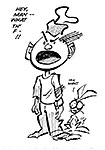
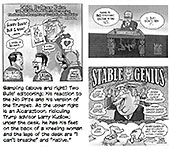
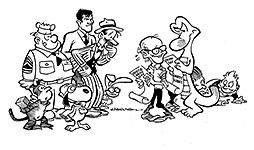

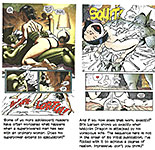
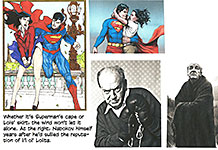
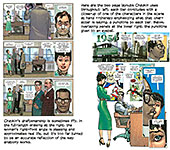
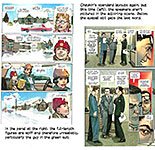

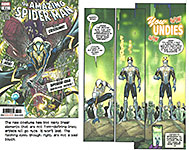
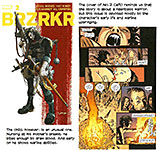
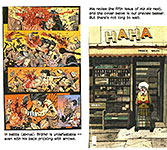
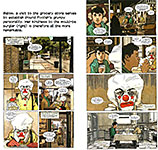

1.jpg)
1.jpg)
2.jpg)
3.jpg)
4.jpg)
5.jpg)
6.jpg)
7.jpg)
8.jpg)
1.jpg)
2.jpg)
3.jpg)
4.jpg)


